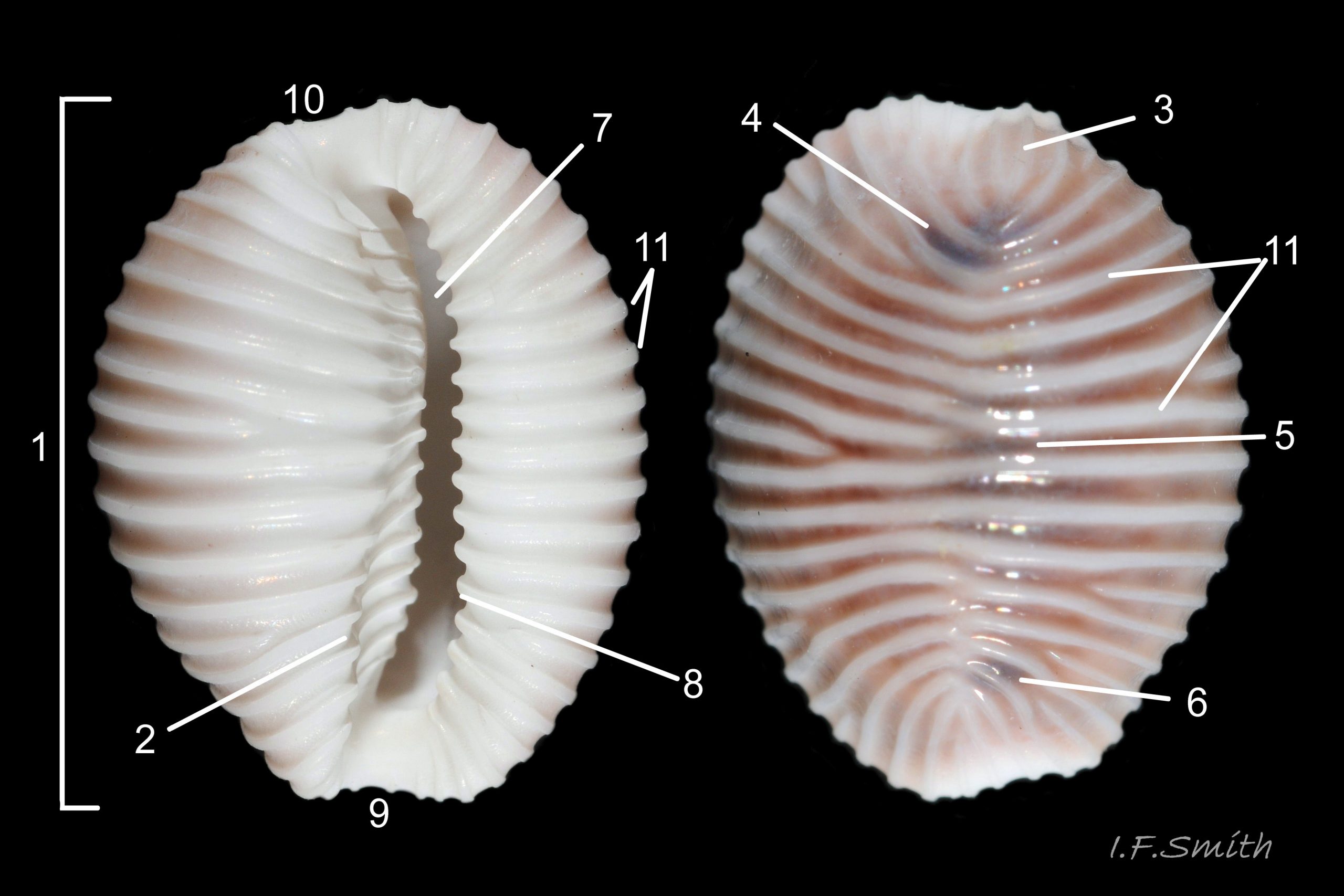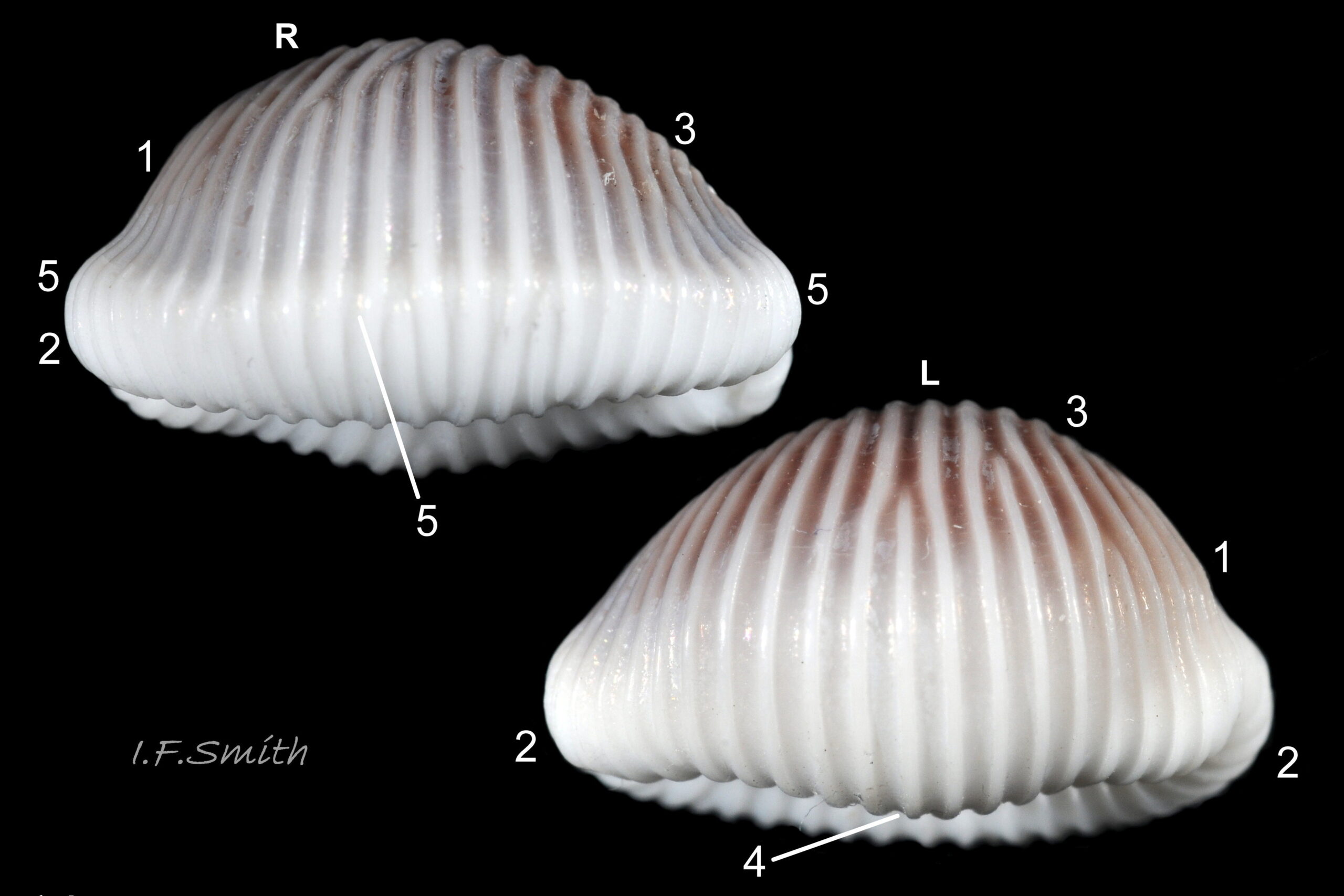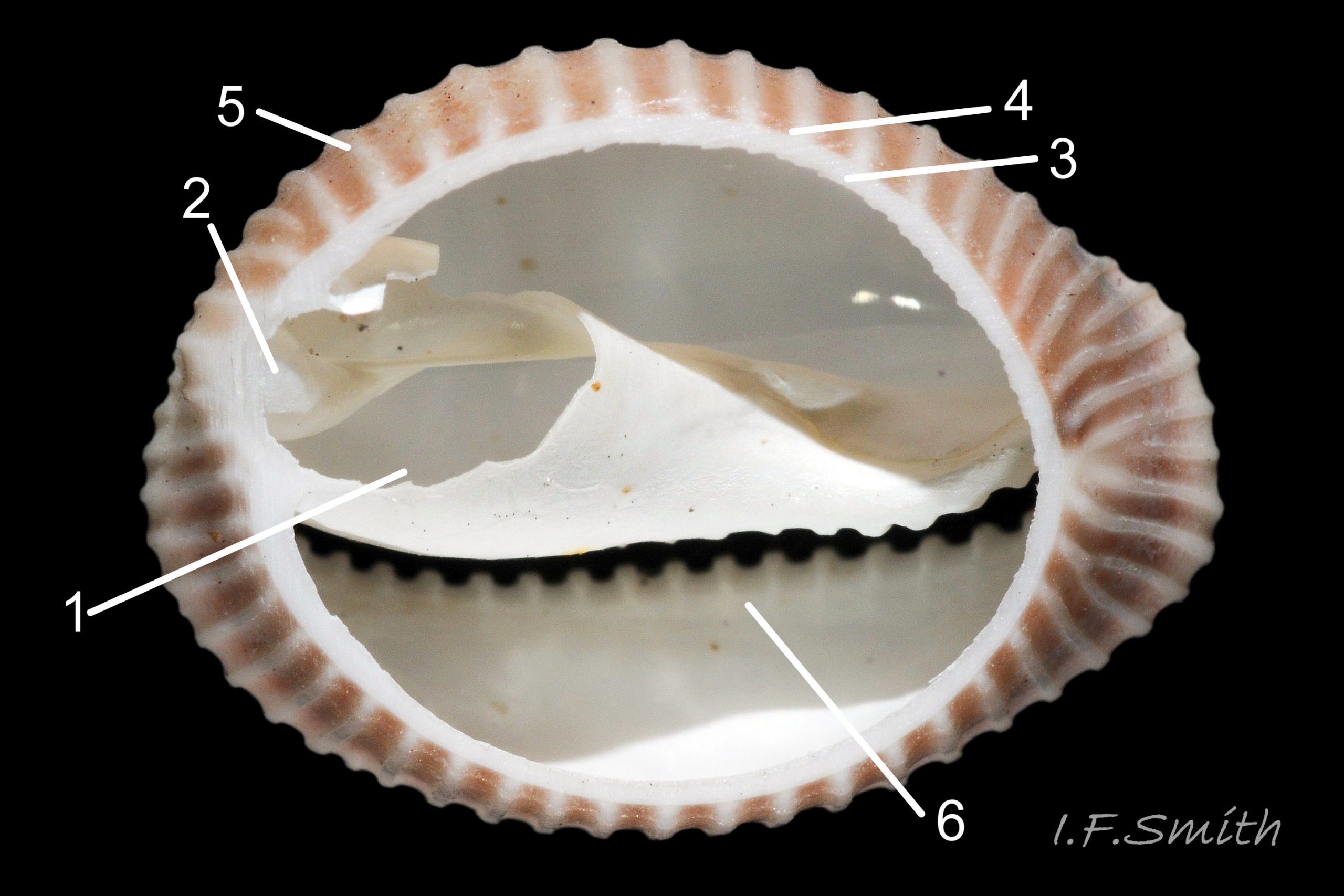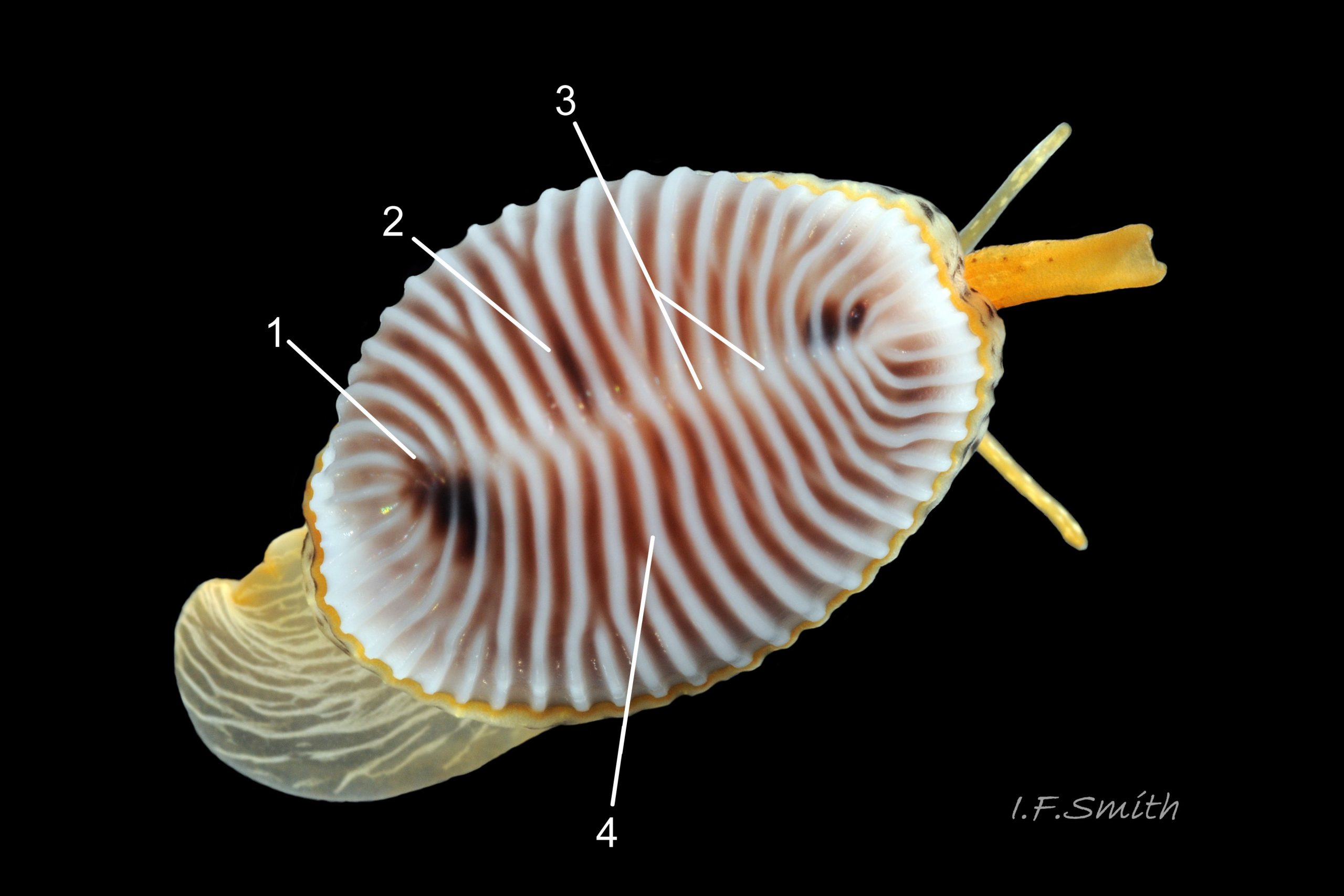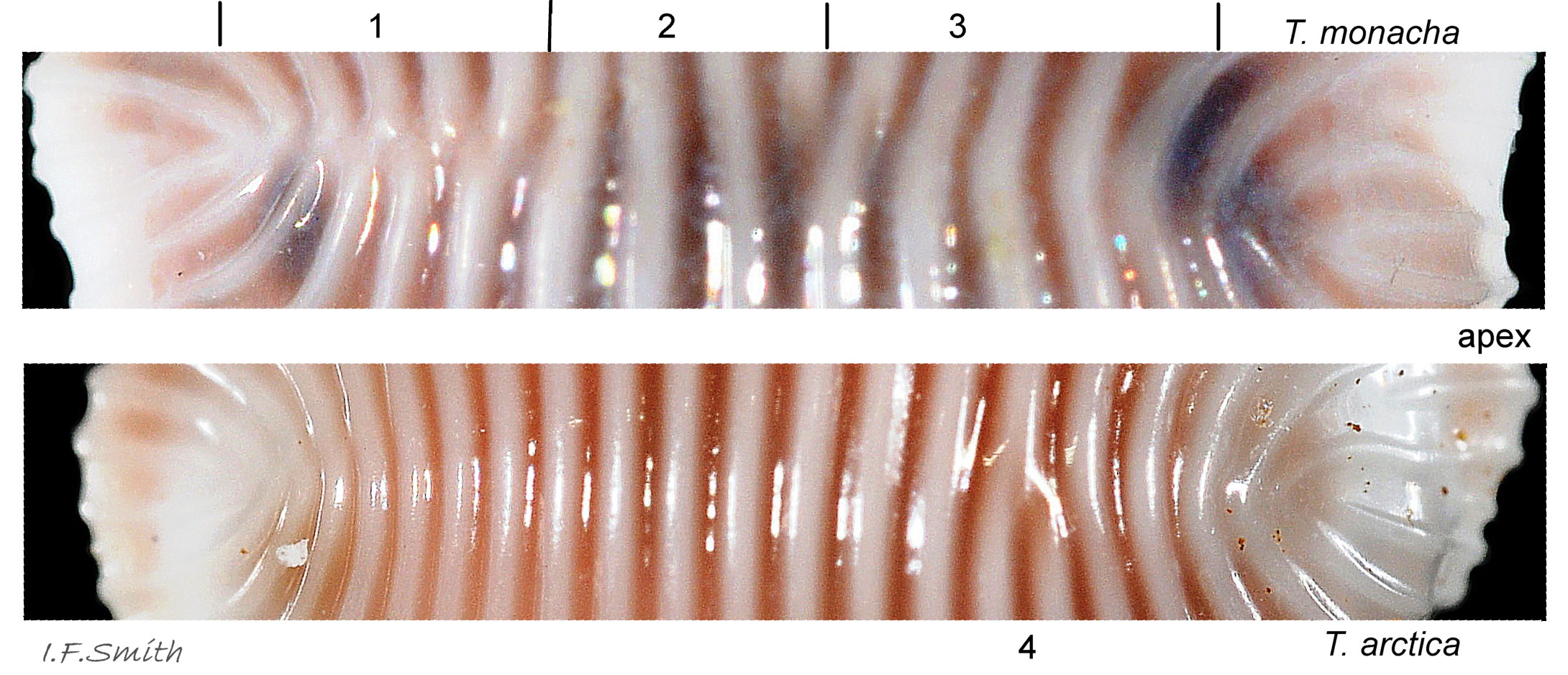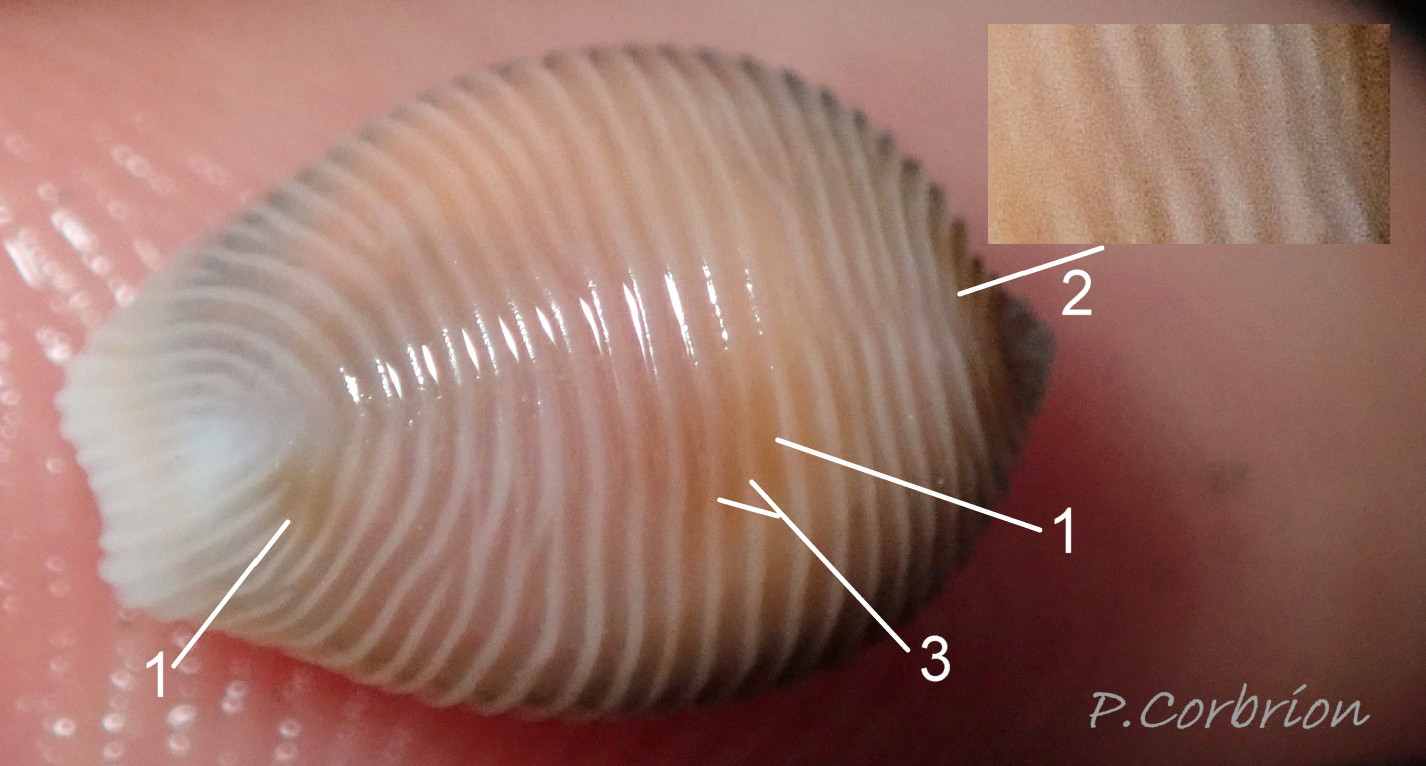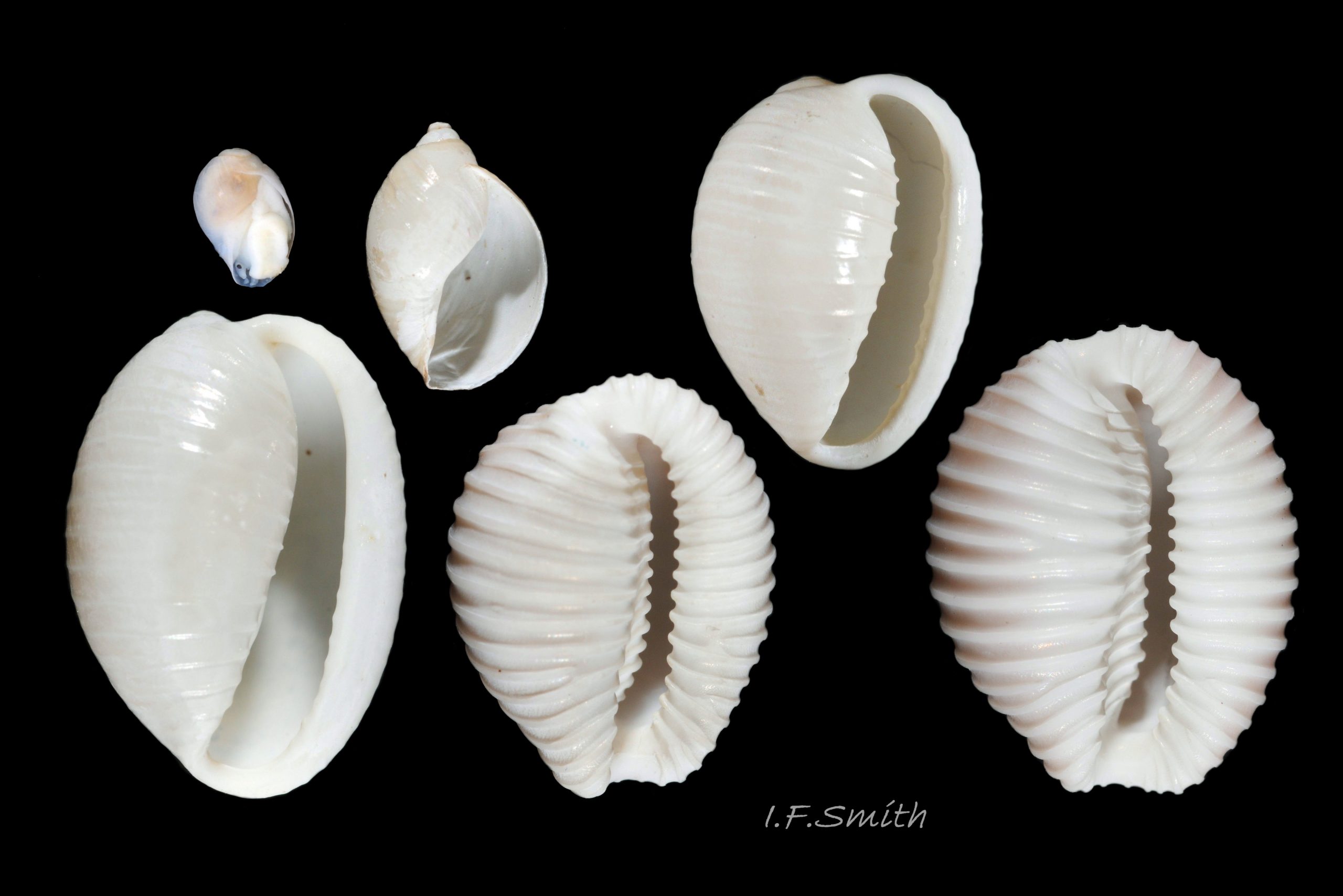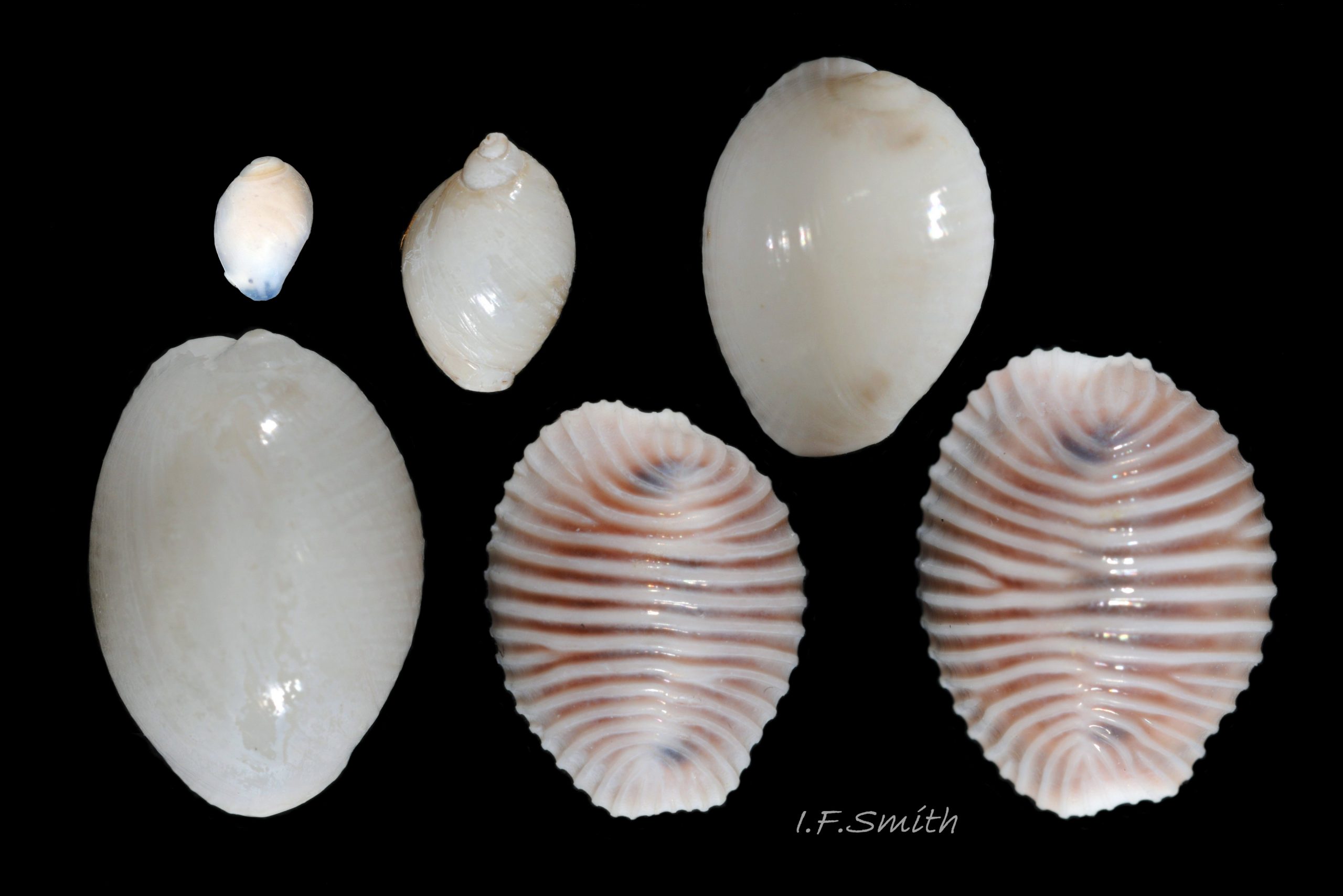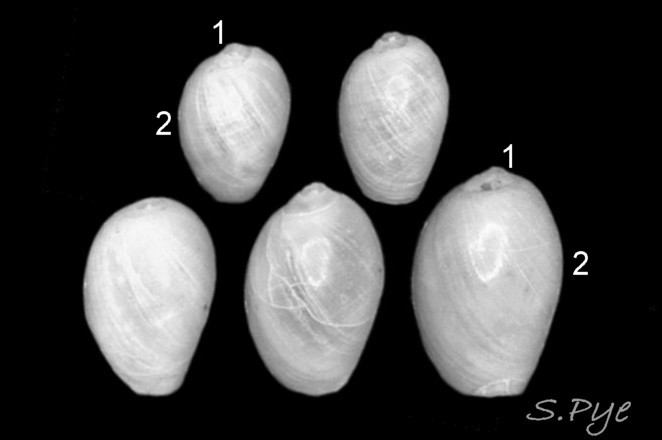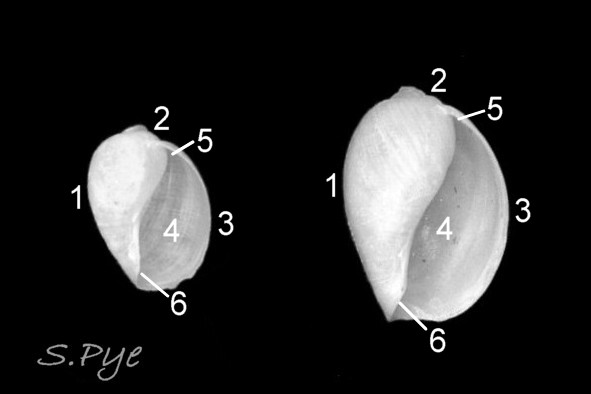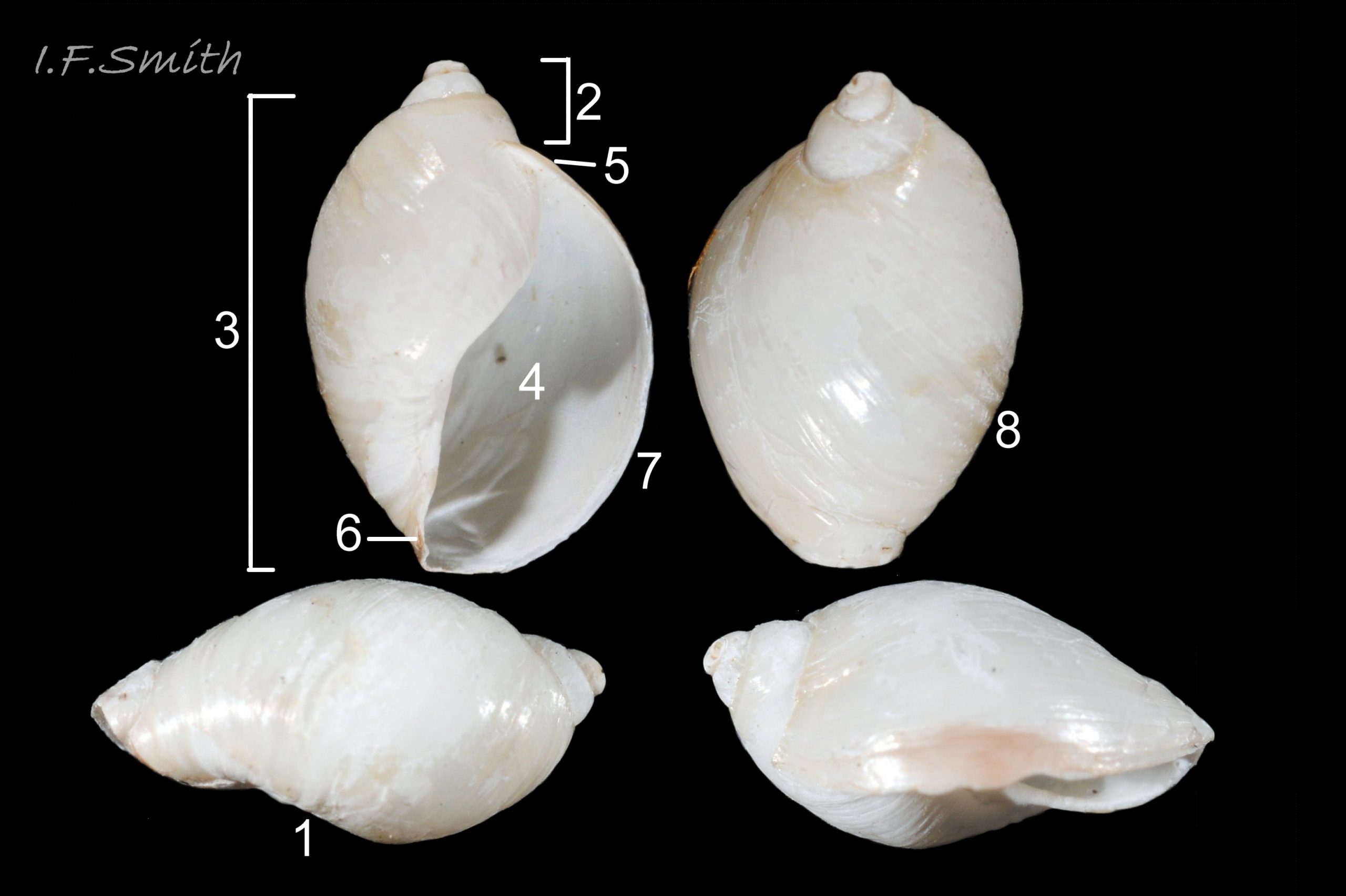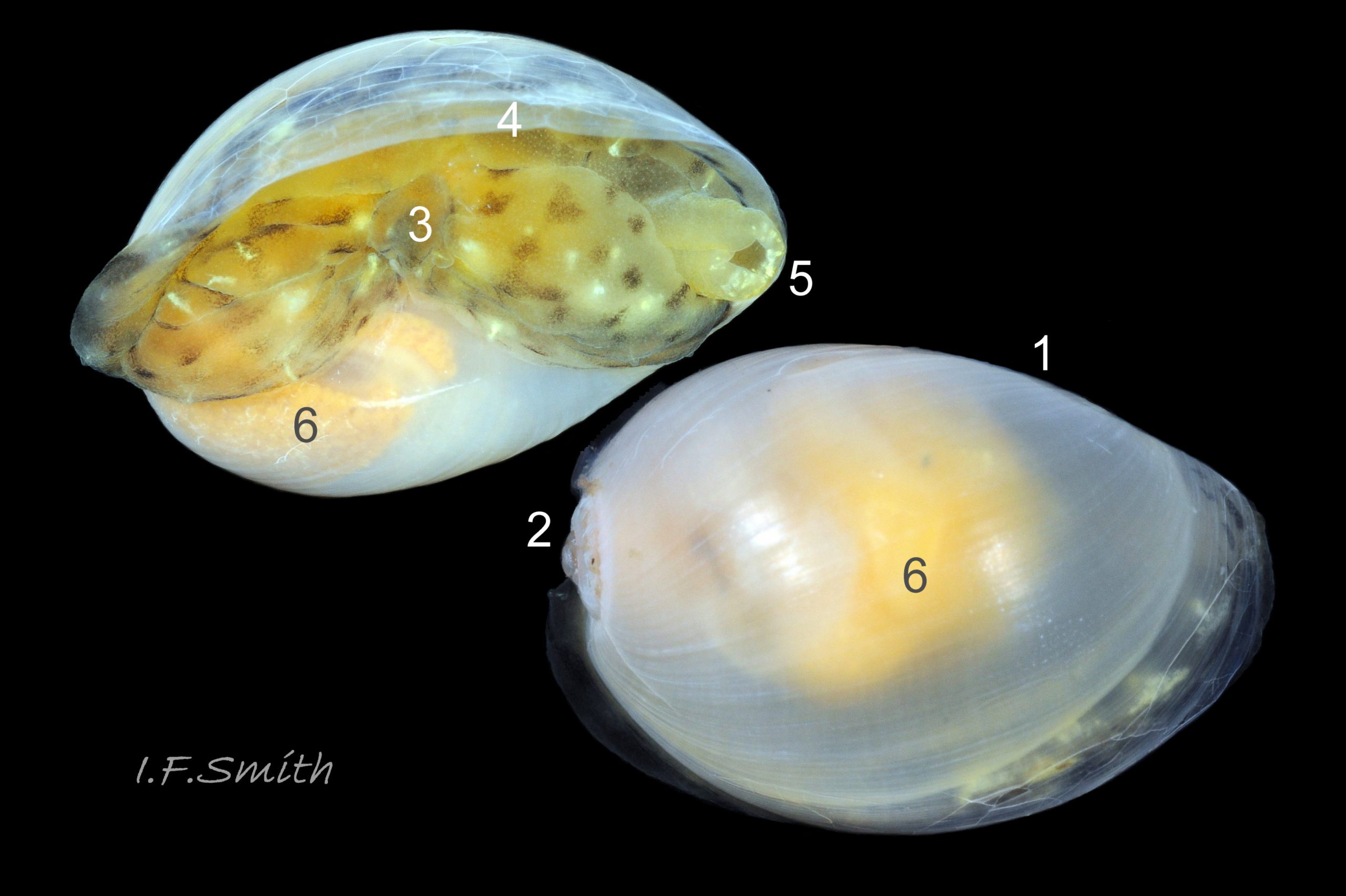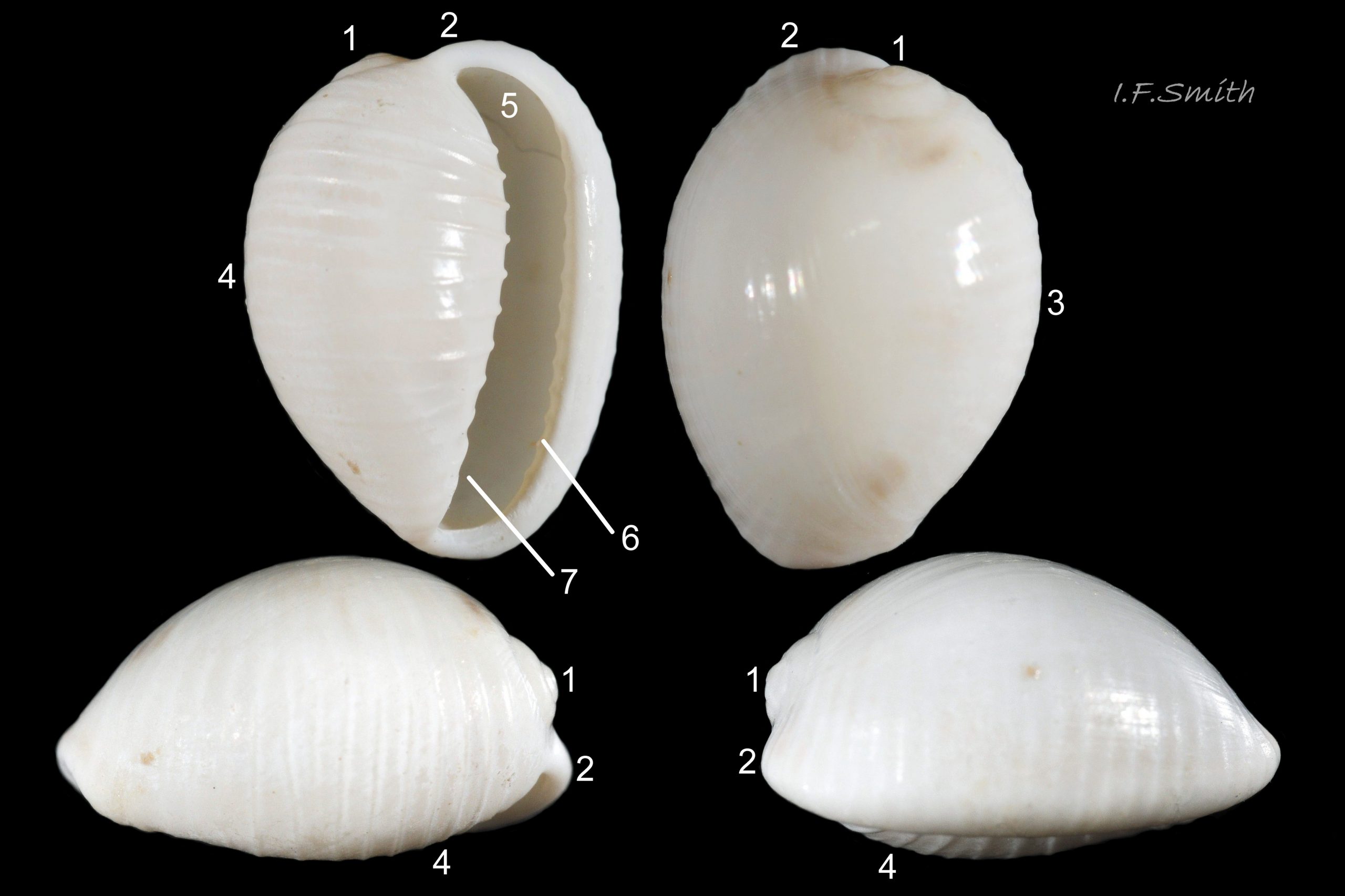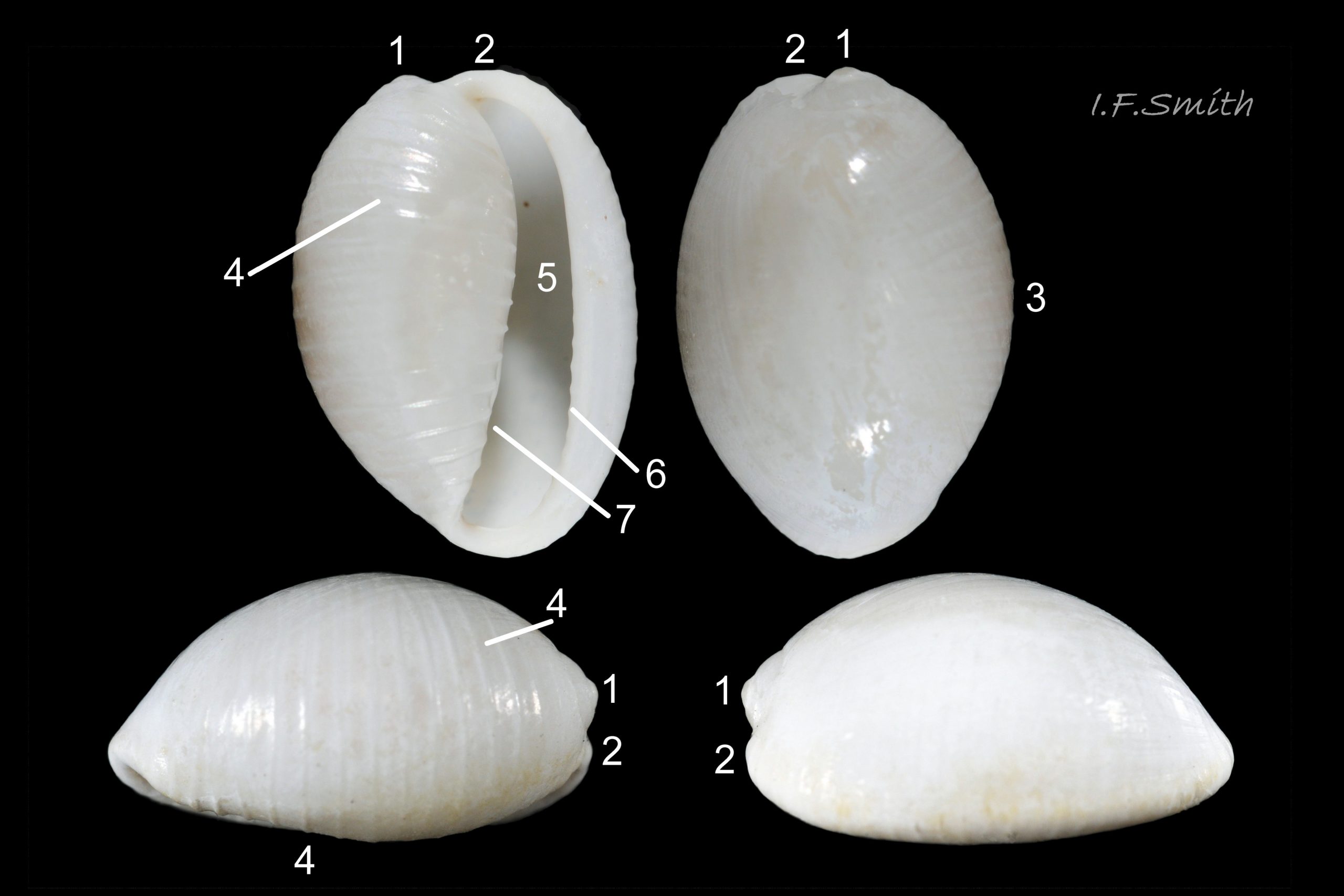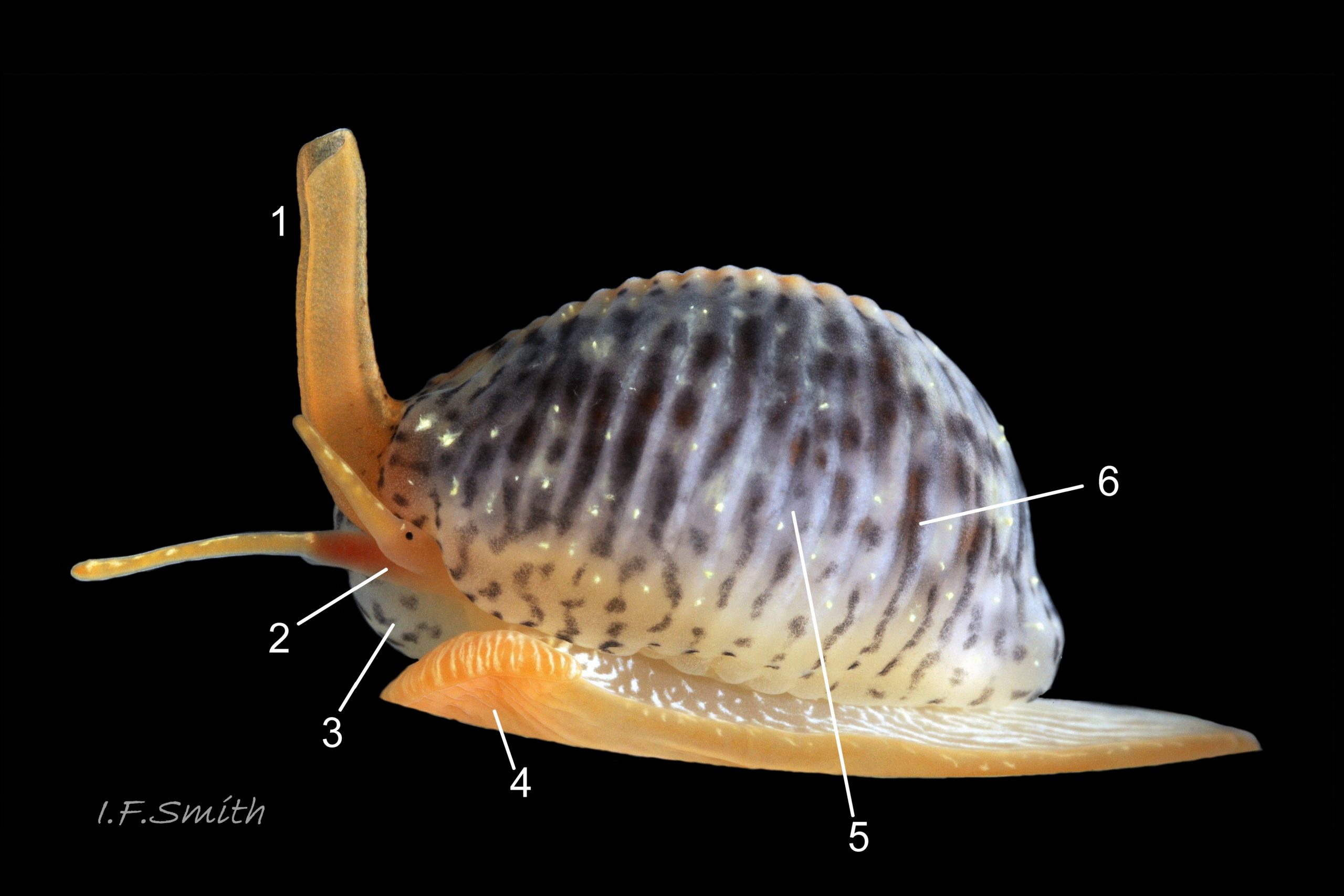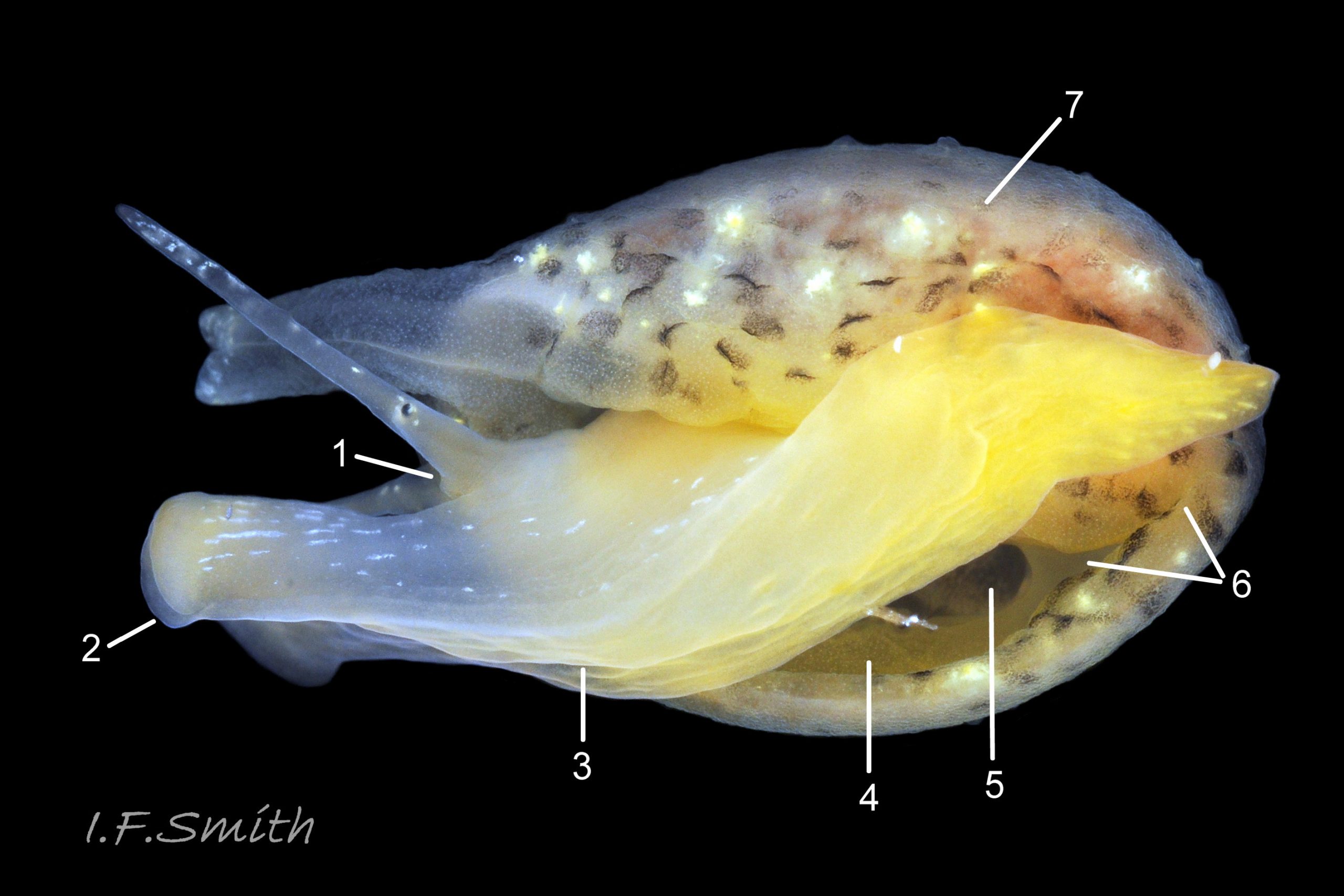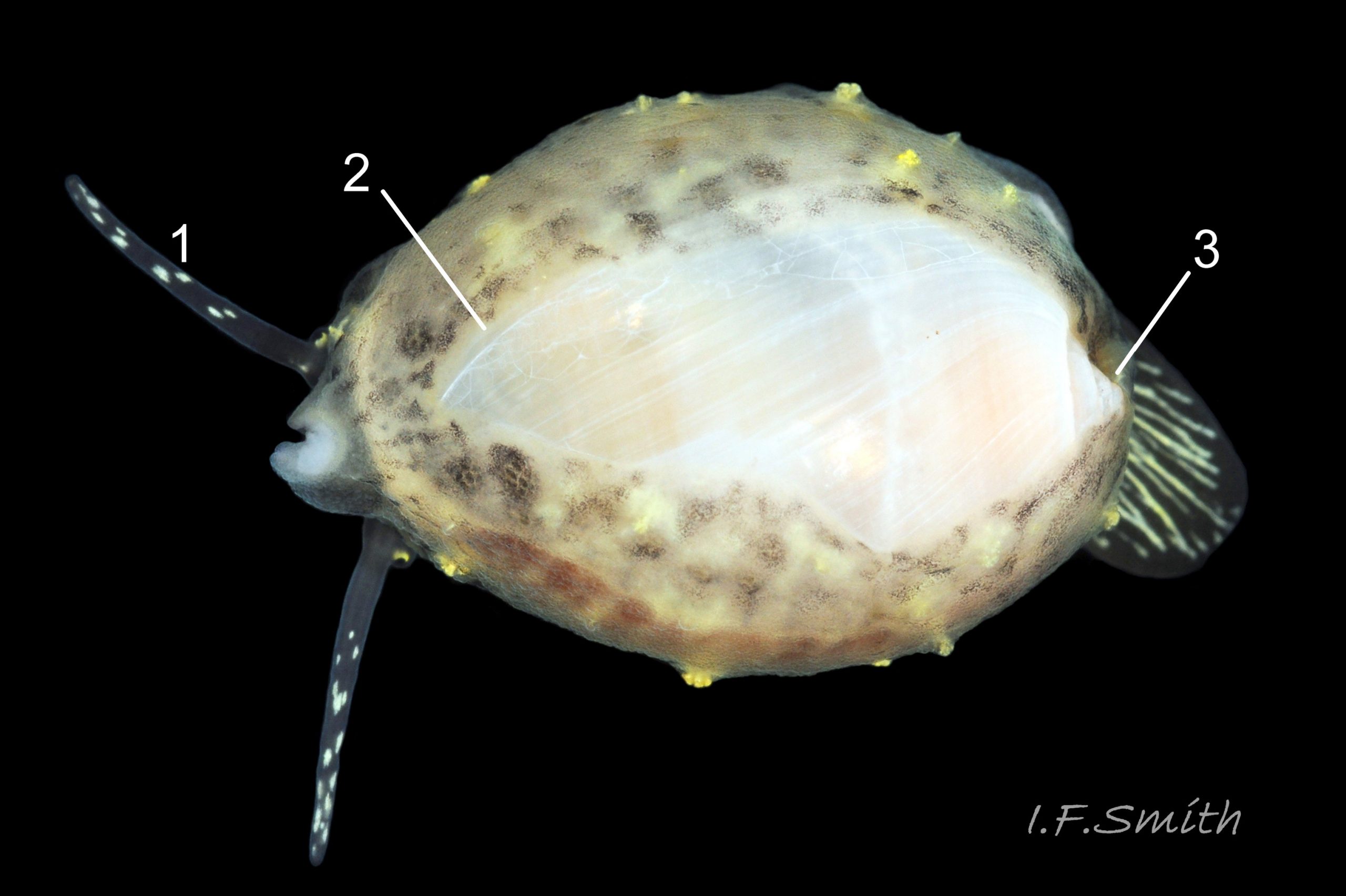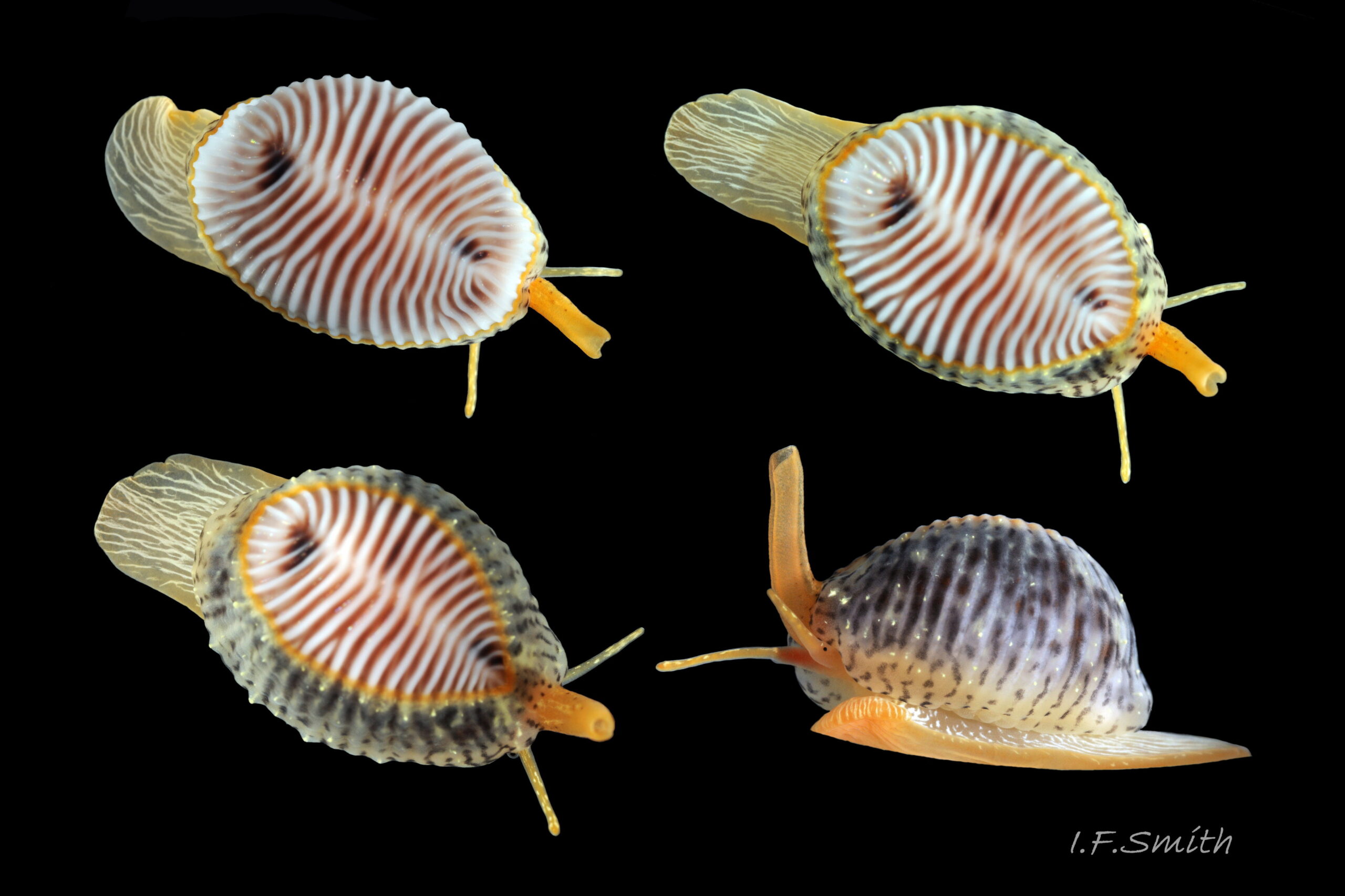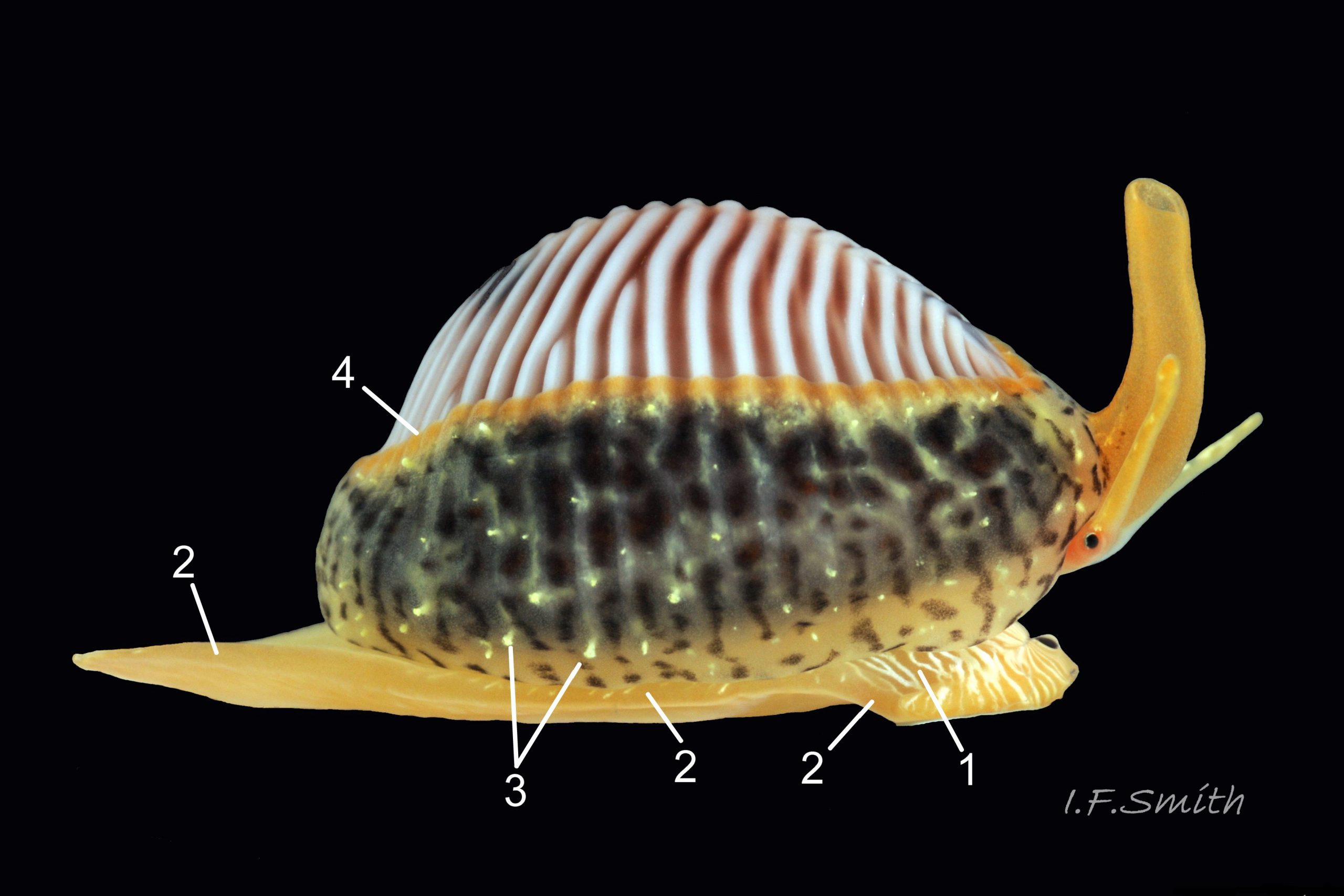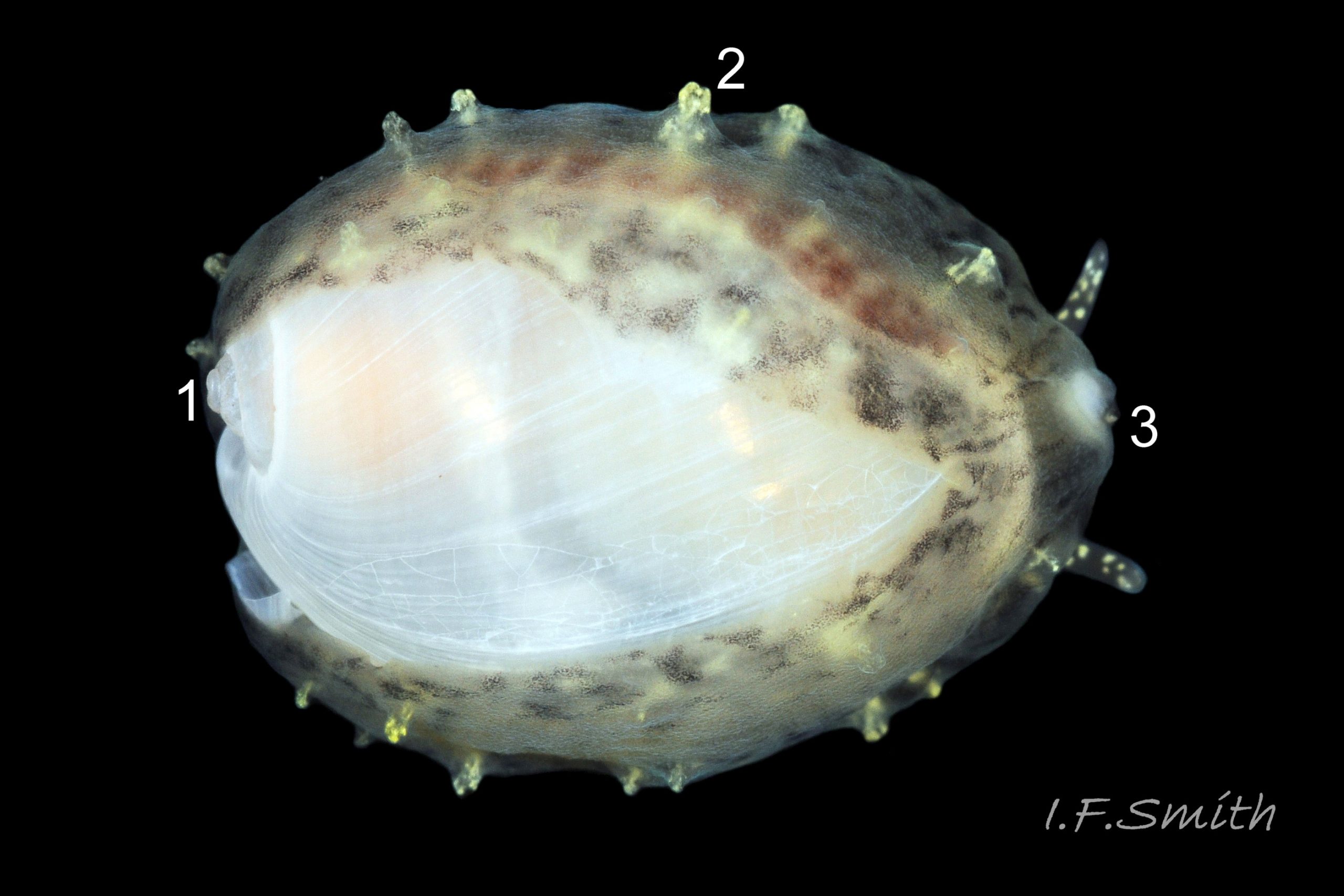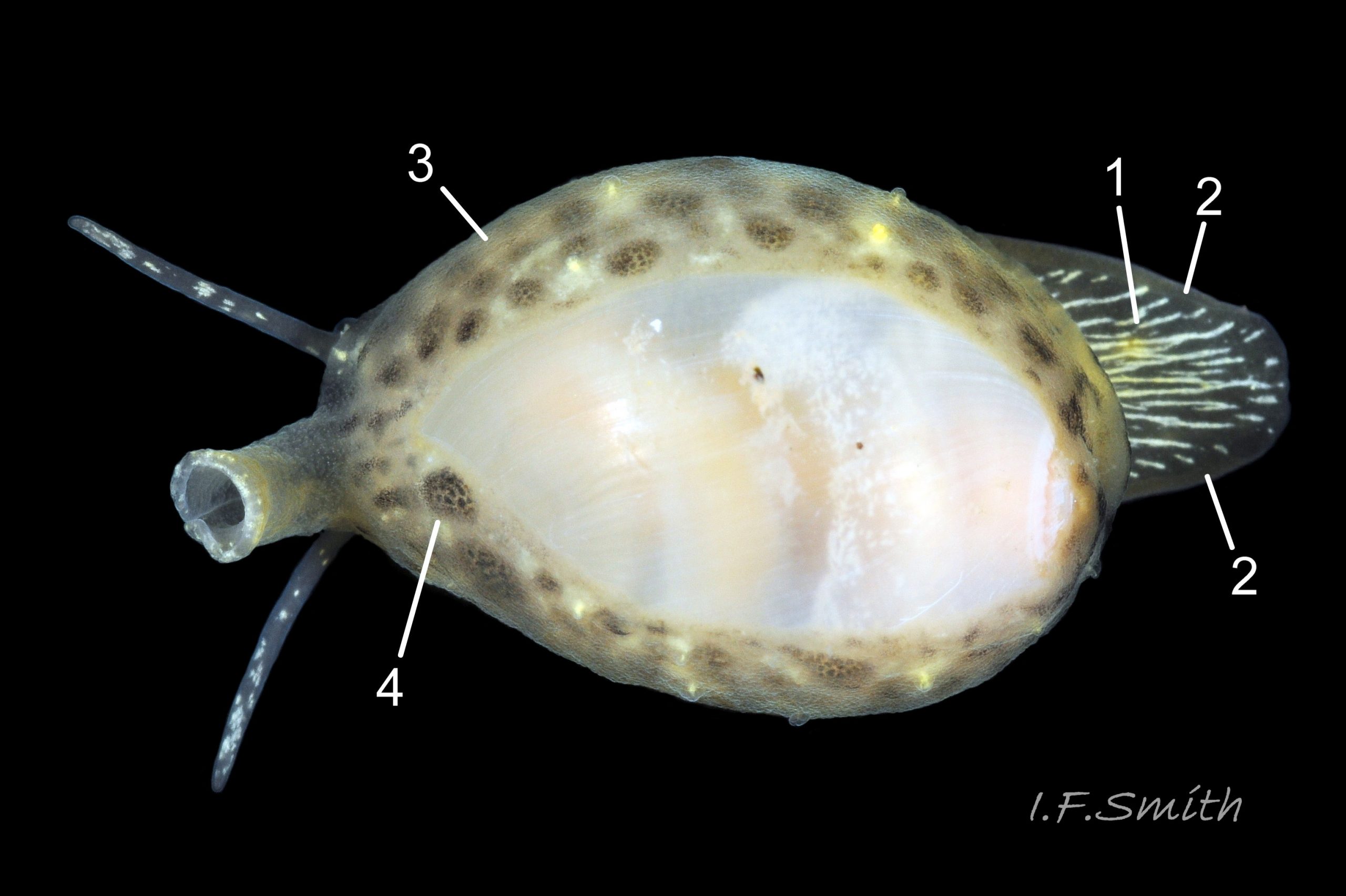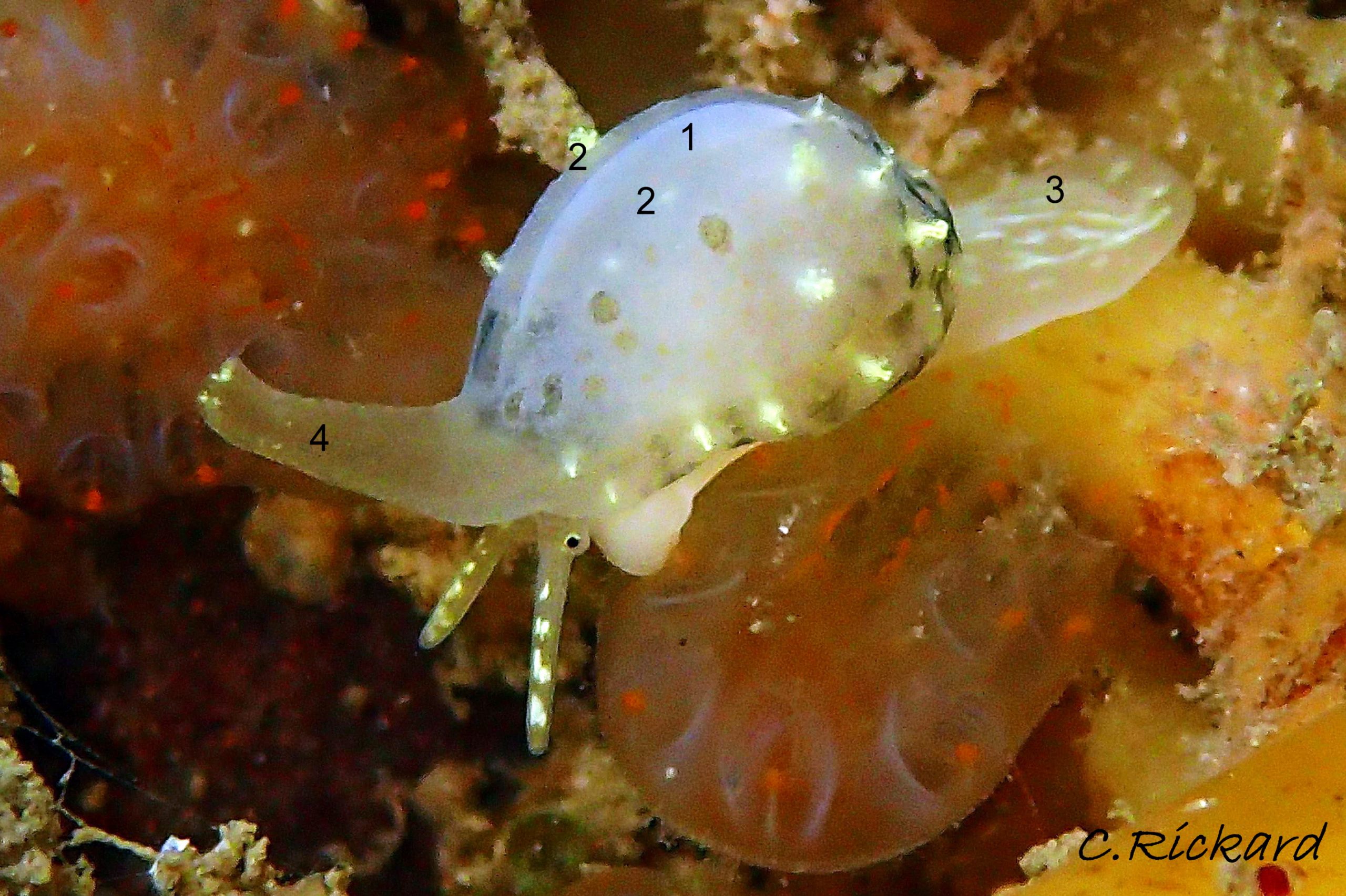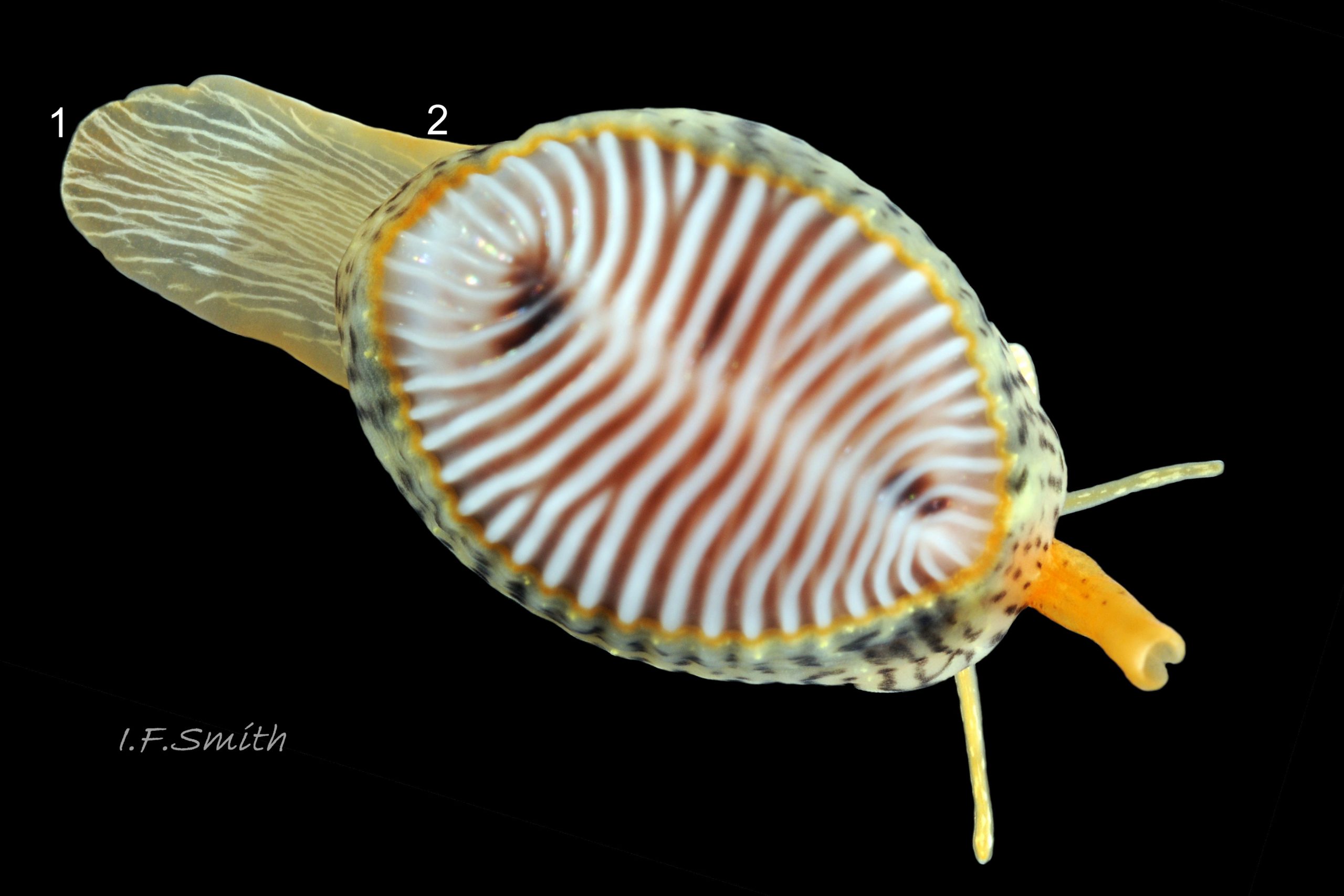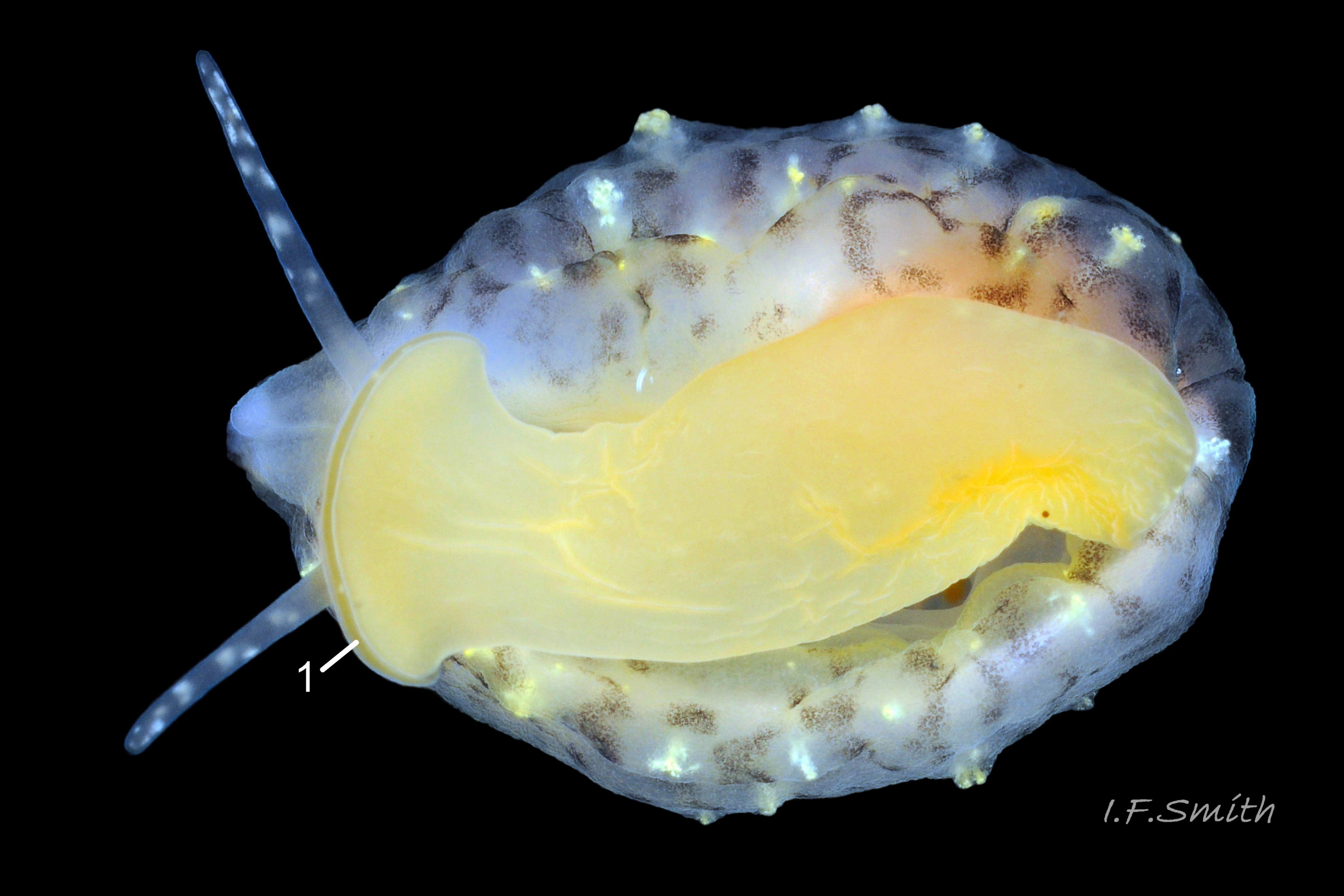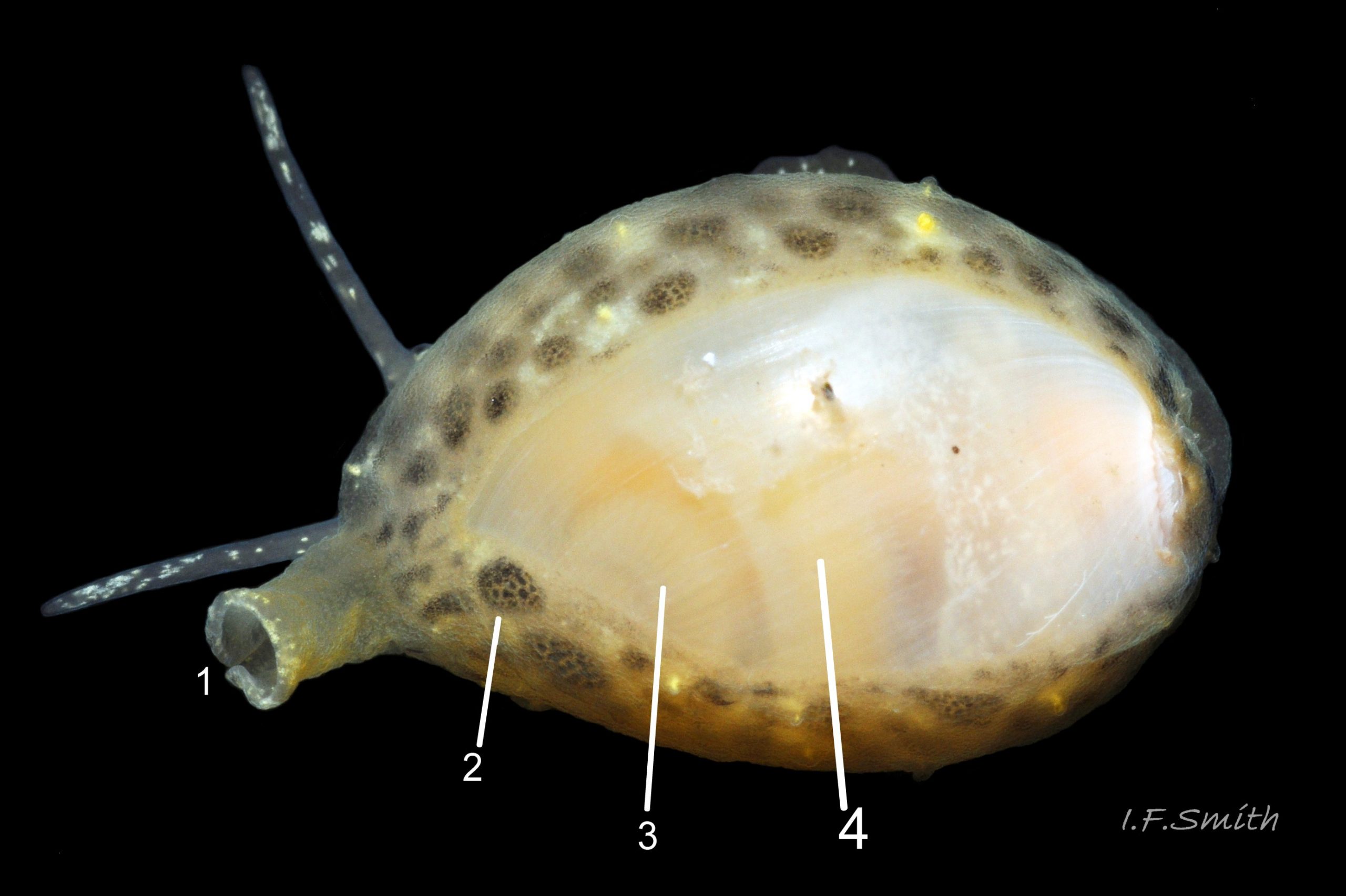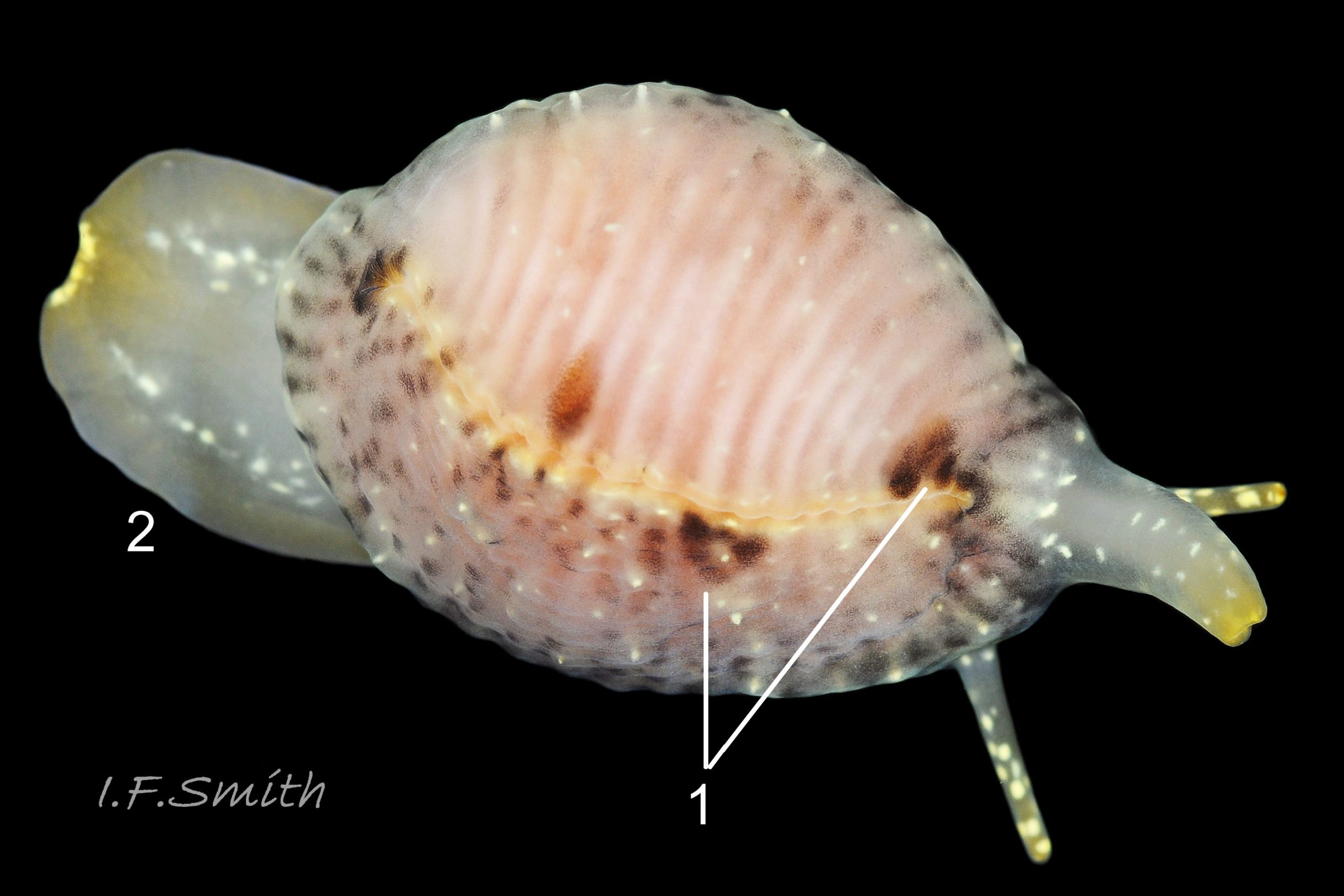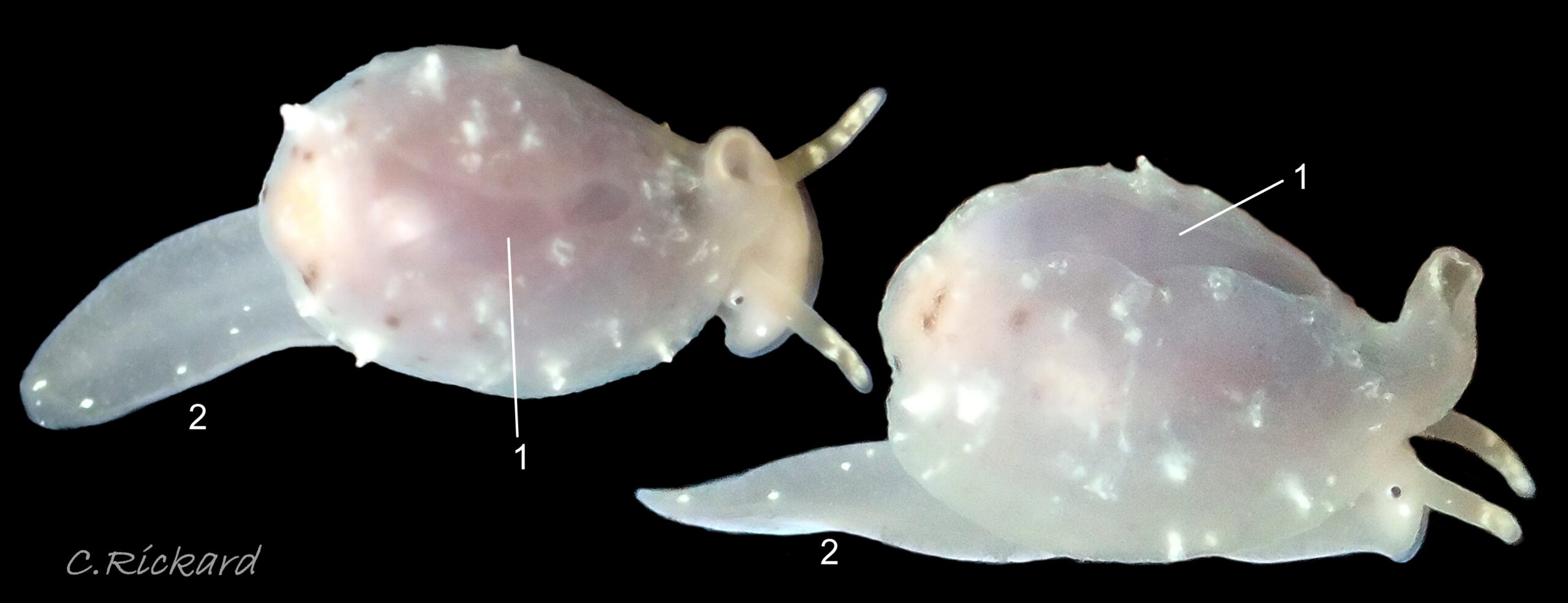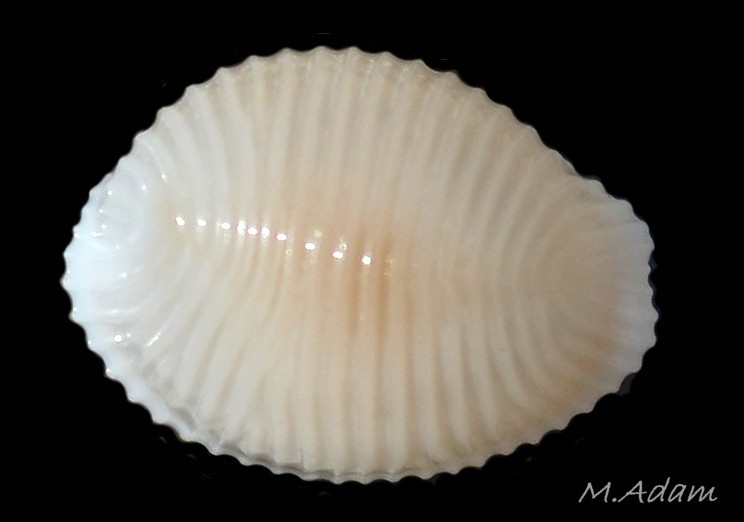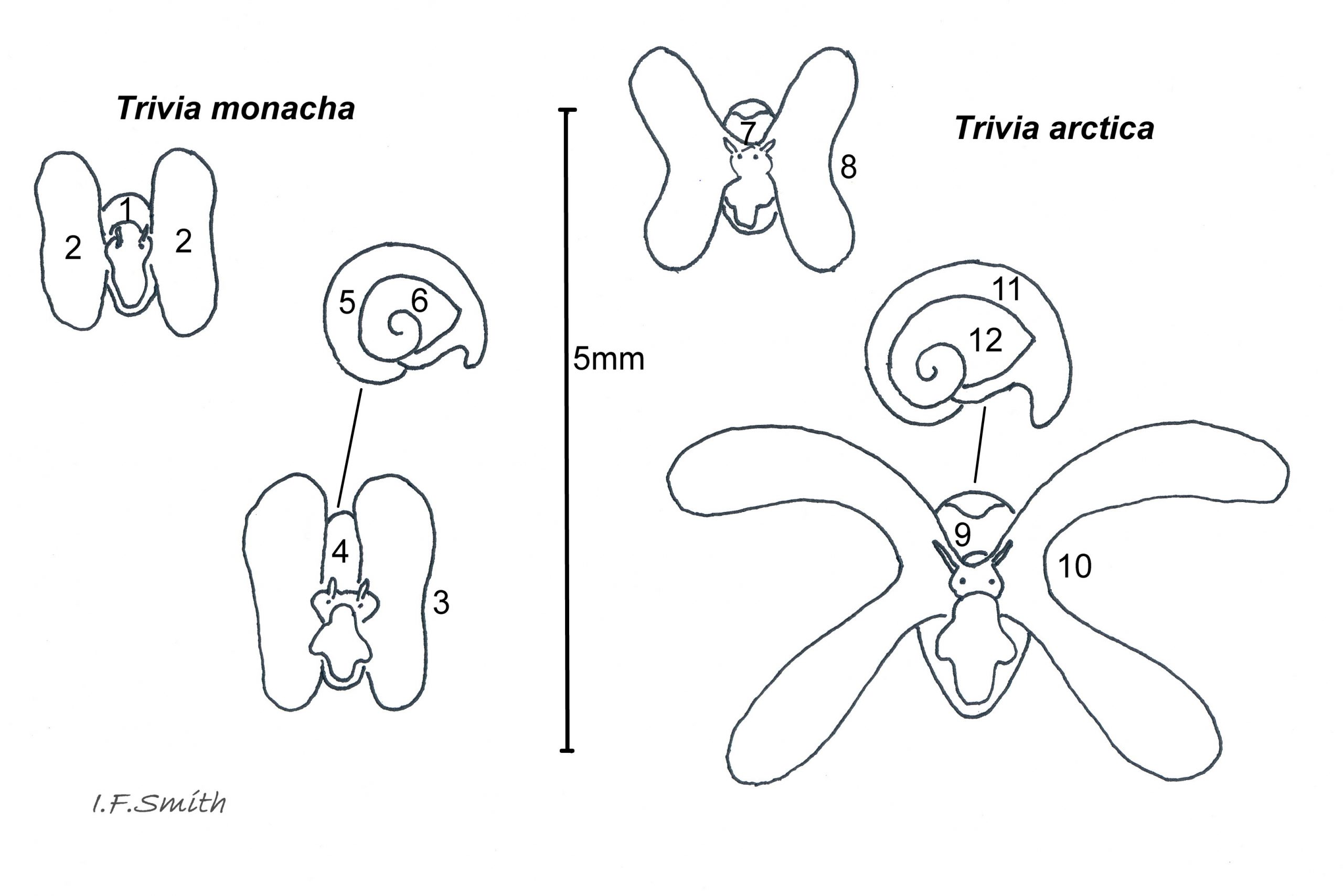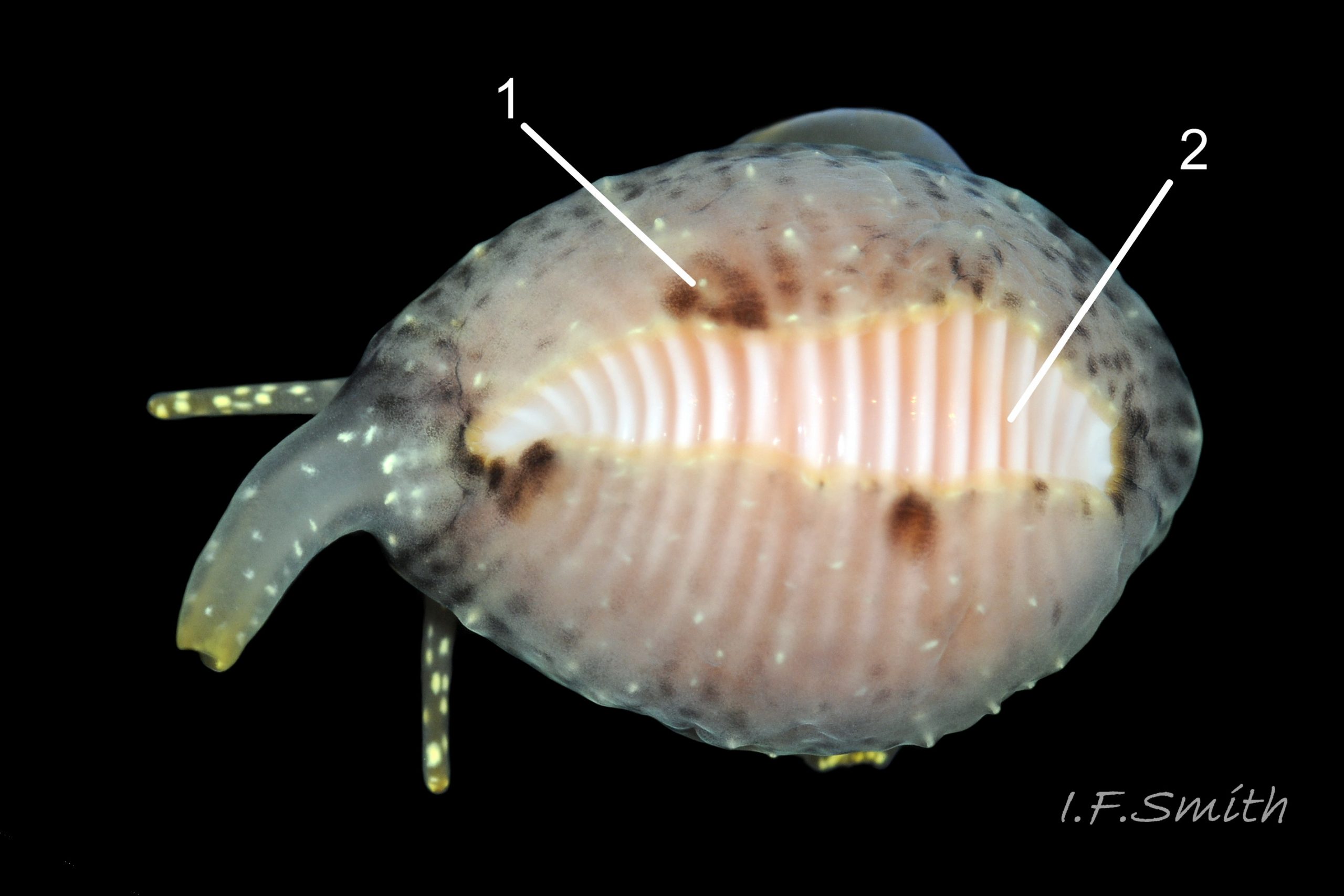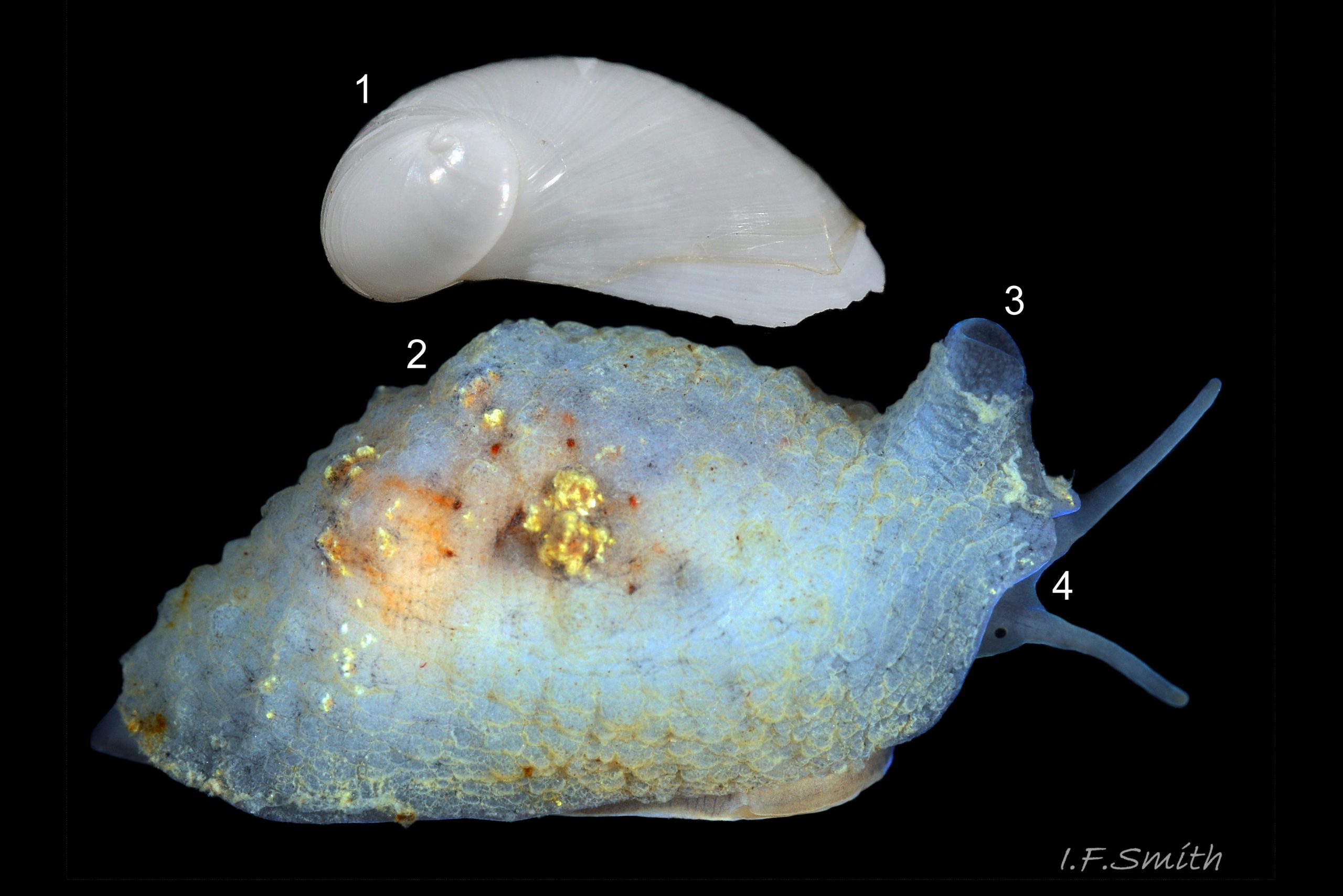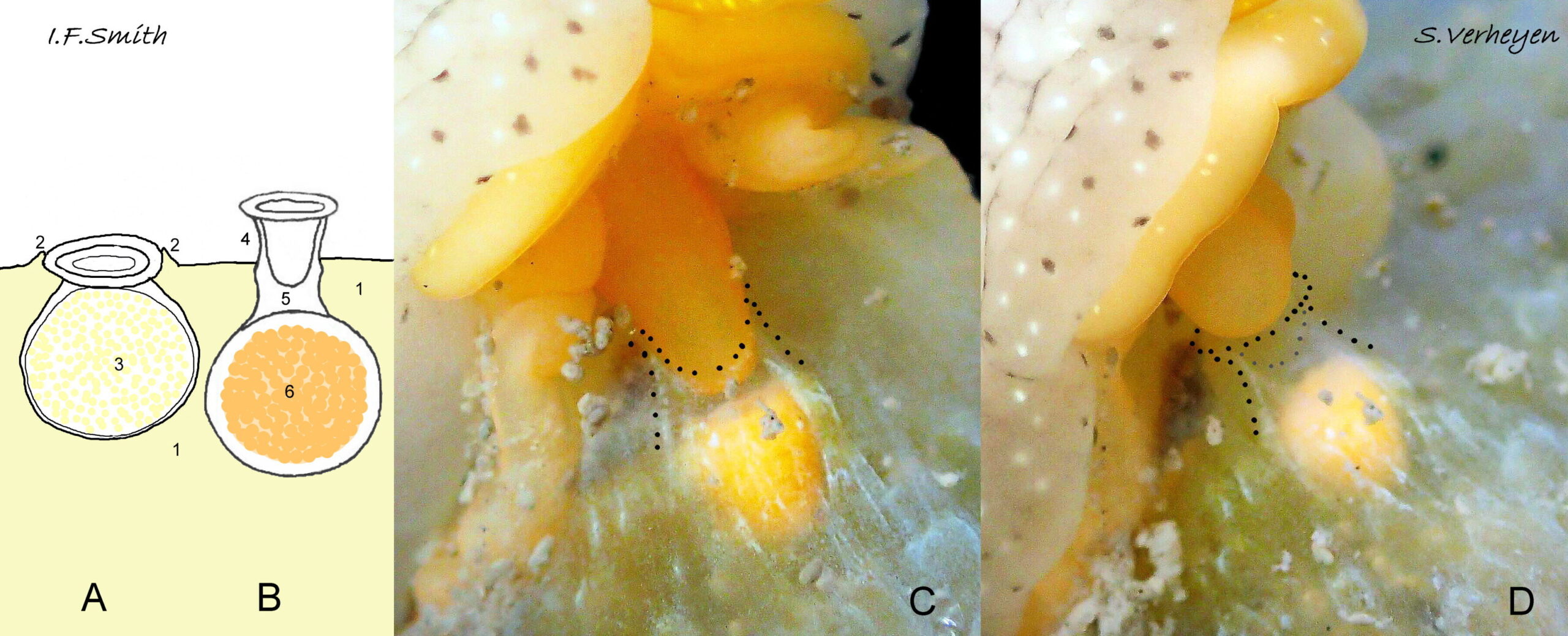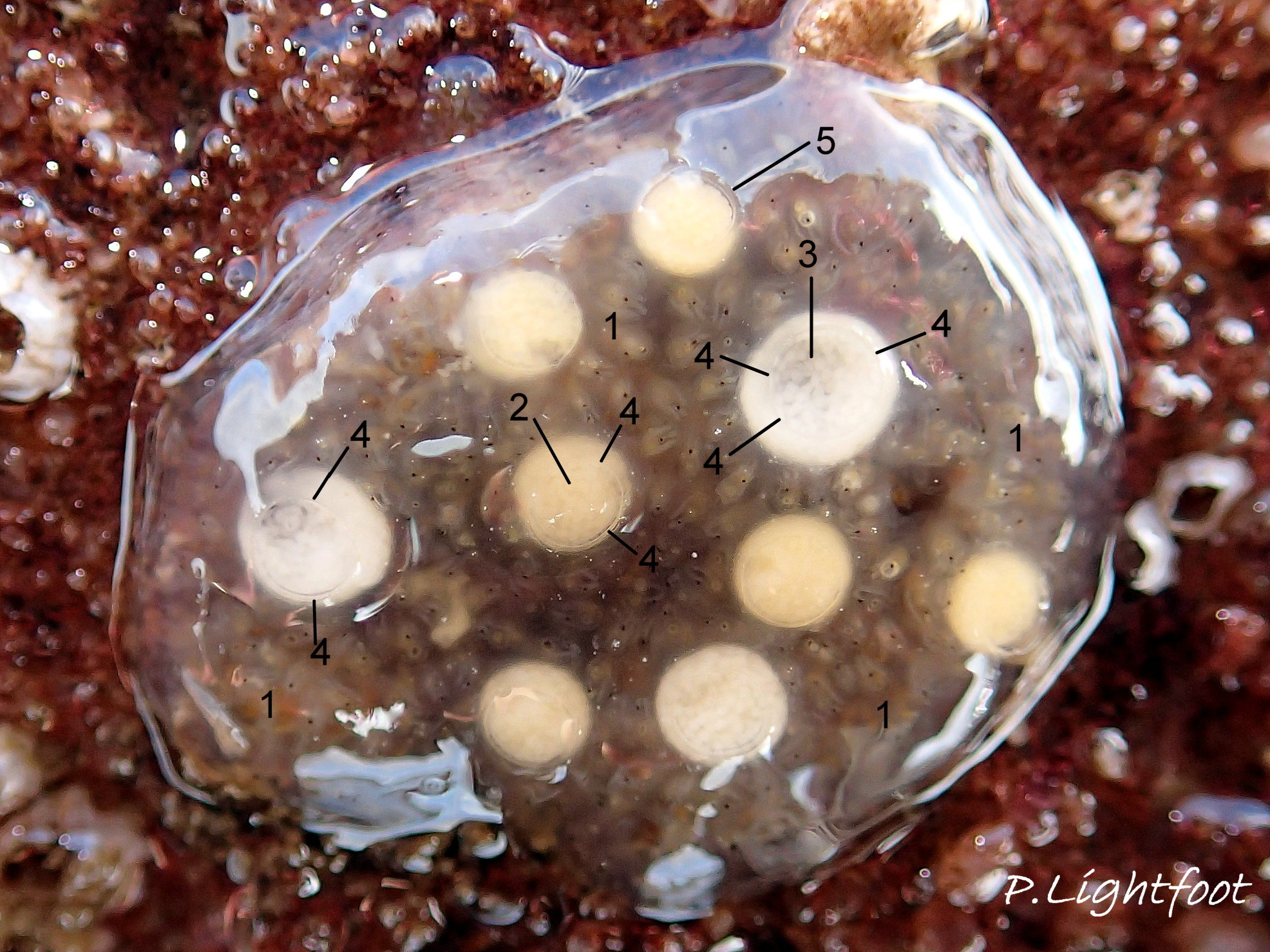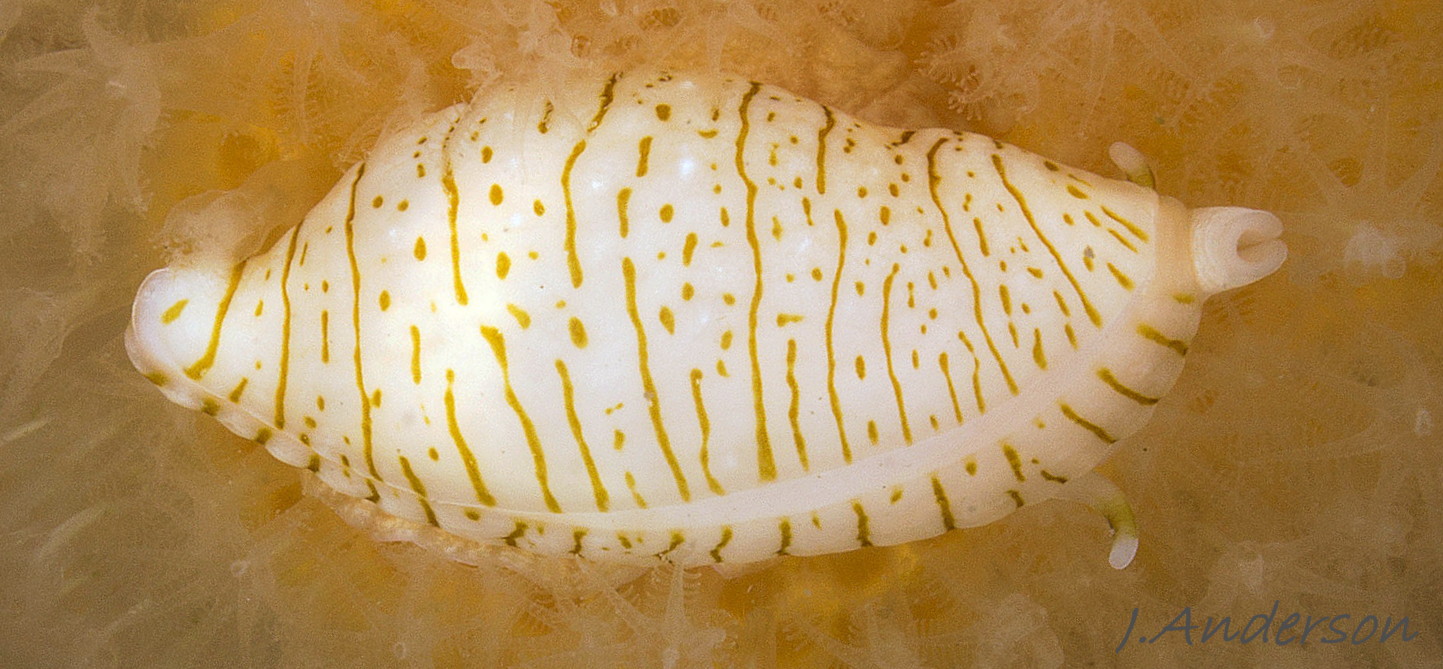Click image to enlarge with full caption. Main text below slider.
Trivia monacha (da Costa, 1778)
Synonyms: Cypraea monacha da Costa, 1778; Cypraea europaea Montagu, 1808 [ = aggregate of T. monacha and T. arctica in Forbes & Hanley, Jeffreys, and many authors pre-1925]; Cypraea europaea var. tripunctata Bucquoy, Dautzenberg & Dollfus, 1883
Current taxonomy: World Register of Marine Species (WoRMS) http://www.marinespecies.org/aphia.php?p=taxdetails&id=141744
Meaning of name: Trivia (Latin) = a common thing
monacha (Greek) = solitary, or (Latin) = nun.
Vernacular: Spotted cowrie (English); Gevlekt koffieboontje (Dutch); Porcelaine tachetée (French).
Names applied to both T. monacha and T. arctica: European cowrie, nun, sea-cradle, maiden, stick-farthing, (English); Groatie-buckie (Scots); Cragen Fair (Welsh); Europäische Kauri (German); Pucelage; Pou-de-mer; Porcelaine puce; Grain de café (French); Kaffebønne (Norwegian); Freirinha (Portuguese) .
GLOSSARY below.
Adult shell description
In Britain, adult shells are usually not less than 10 mm and up to 13 mm high (longest dimension of shell) by about 8 mm wide 01 Trivia monacha. They are broadest towards the apical end. Pelseneer (1932), in Lebour (1933), states height extremes are 8.35 to 15.4mm. The adult shell is ovoid with a flatter apertural/ventral face 02 Trivia monacha which is likened to a coffee bean in Dutch, French and Norwegian and to a kernel of oats in Scots. The adult shell is convolute, meaning that all earlier whorls are hidden from view by the enveloping final whorl. A slight pimple or mound on the posterior end sometimes indicates the position of the hidden apex. It is solidly built with a sculpture of 20 to 25 ribs crossing entire the shell with a few short intervening ribs. The grooves are about the same width as the ribs. Nearly always, some of the ribs of left and right sides are not perfectly aligned where they meet on the dorsum 04.1 Trivia monacha & 04.2 Trivia monacha. There is a thickened white labial varix on the palatal side of the aperture 02 Trivia monacha.
The aperture is a gently curved slit along the entire height of the shell. It is positioned ventrally on the living animal. The outer (palatal) lip of the aperture curves out of sight into the interior of the shell 01 Trivia monacha. The columellar region is a concave furrow and its ribs protrude as teeth. A wide extension of the aperture at the anterior forms an inhalant siphonal canal, and a narrower extension at the posterior forms an exhalant siphonal canal.
Colour: the opaque shell is white internally and externally, apart from a thin external pinkish layer deposited, when adult, in the grooves dorsally and laterally by the external mantle 03 Trivia monacha The mantle also deposits three pitch-brown/black dorsal marks on the shell dorsally 04 Trivia monacha. The posterior mark is usually the largest. Colours may fade after death 01 Trivia monacha and all colours may be bleached white if exposed to the sun. The ribs and median dorsal stripe receive variable amounts of pigmented layer so may be tinted slightly or remain whitish 04 Trivia monacha. The ventral/apertural surface and labial varix are white 02 Trivia monacha. The shells of live animals are glossy and lack erosion or epizooic growths as they are protected and maintained by the mantle which is able to continue shell deposition on the exterior 01 Trivia monacha. There is no operculum or periostracum on adults.
Post-veliger shell development
Metamorphosis occurs when the echinospira shell is about 1.6 mm diameter (Lebour, 1933). As the outer layer is cast off then (Fretter & Graham, 1962) the initial post-veliger shell is probably smaller.
The flimsy white juvenile shell, lacking operculum or periostracum grows up to 12 mm high and changes form as it grows 05 Trivia monacha & 06 Trivia monacha. Stages A-G, below, merge into each other. Sizes are of specimens photographed; but changes can occur at other sizes because of individual variation.
A) juvenile up to c 3.5 mm high:
The ovoid body whorl makes up 92-96% of the shell height 06.2 Trivia monacha. The very small, 1.2 mm diameter, spire making 4-8% of the shell height, consists of the one and a half whorls of the discoid larval protoconch. It is glossier than the rest of the shell 06.1 Trivia monacha. There is no umbilicus and no sculpture apart from fine prosocline growth lines. The D-shaped aperture is 82-96% of the shell height. It is wide open basally and narrows adapically 06.3 Trivia monacha. The adapical angle is narrow. The palatal (outer) lip is thin and semi-circular and there is a short, thin columellar lip basally.
B) juvenile 6.4 mm high: 07 Trivia monacha
The shell is as at stage A, except that it has developed a distinct spire, 15.5% of the shell height,of 3-4 convex whorls with distinct sutures. The body whorl is c. 92% of shell height and the D-shaped aperture c.84% of shell height. The adapical angle of the aperture is c. 25º.
C) juvenile 9.3 mm high: 08 Trivia monacha
The shell is more ovoid and the body whorl and aperture are 100% of shell height. Most snails increase the relative length of spire with growth at this stage, but on Trivia it is reduced to 5% of height, and exposed level with the top of body whorl. The adapical angle is wider and the columellar lip is no longer differentiated.
D) juvenile 9.6 mm high: 09 Trivia monacha
The spire is c. 3% of shell height. A sculpture of ribs and grooves has commenced formation on the apertural face (ventral face when animal alive). It now has a gently curved linear aperture, as on adults but wider, and the palatal lip is bent into the aperture so its edge is hidden.
E) juvenile 11.7 mm high: 10 Trivia monacha
The spire is c. 2.5% of height and there is a slight development of ribs on the abapertural (dorsal) surface. At this stage the shell is often larger than some adults. This appears to because the mantle changes in parts to resorb, instead of deposit, calcium carbonate during the change to adult. This was disputed by Forbes & Hanley (1853), but close examination of specimens undergoing the change show grooves cut below the level of the yet unaffected juvenile areas of the shell, leaving ribs of juvenile shell between the grooves 11 Trivia monacha.
F) pre-adult:
Post-veliger juvenile shells grow in the normal three-layered spiral fashion of most other snails (Meyer & Paulay, 2005). This changes as the transition to adult takes place when i) the spire is completely enveloped by the body whorl, ii) the shell is thickened mainly internally, but also externally, with layers of differing crystalline structure, iii) the ribs form teeth along both sides of the narrowed aperture and along inhalant and exhalant siphonal canals, iv) ribs and grooves complete formation ventrally and dorsally on the body-whorl.
G) adult: 01 Trivia monacha
Shell development is completed with deposition dorsally by the extended mantle of a thin, outermost pinkish layer, mainly in the grooves 03 Trivia monacha Ventrally, the shell remains white. For short time until three blotches of pitch-brown/black pigment are deposited on the dorsum of the shell it may resemble T. arctica.
Body description
Morphologically, apart from reproductive organs, the soft body parts are similar on adults and post-veliger juveniles, but pigmentation is paler and pattern differs on juveniles.
The flattened head is flanked by stout eye-peduncles fused to the bases of the cephalic tentacles. On adults it is red-brown, red, orange or sulphur-yellow, sometimes with yellow spots. On juveniles it is whitish. It can open-wide 12 Trivia monacha or fold-shut 13 Trivia monacha along the ventral mid-line where there is an unobtrusive, small snout with an opening to a pouch containing the feeding proboscis 14 Trivia monacha. The cephalic tentacles arelong, slender, translucent and the same range of colours as the head, but sometimes a paler shade 15 Trivia monacha & 16 Trivia monacha, often with opaque, hyphen-like streaks of yellow or, on juveniles, white.
The long inhalant siphon, a rolled extension of the mantle13 Trivia monacha, is coloured as the head or, often, a stronger shade and sometimes with black flecks https://flic.kr/p/aaiJPB (D. Cooke). It protrudes, usually held erect, from a short, wide anterior siphonal-canal in the shell; 13 Trivia monacha. An exhalant siphon formed by fold of mantle rests within posterior siphonal canal of the shell 17 Trivia monacha & 14 Trivia monacha. The much thickened and lobulated, translucent mantle can extend over the entire exterior of the shell 18 Trivia monacha. On adults it is usually whitish ventrally and greyish laterally and dorsally, with dark marks, often merging into lines aligned over the underlying shell-grooves 13 Trivia monacha. The mantle rim usually has an uninterrupted orange border of varying intensity 15 Trivia monacha. The hue of the grey areas and dark marks varies between individuals; they may be blue-grey, purple-grey or purple-brown https://flic.kr/p/bMBBvt (J. Weir) and may be suffused orange. Colour saturation varies between individuals, and on any individual increases with degree of mantle contraction. Specimens from southern locations tend to have more saturated colours, including dark brown. Light yellow or whitish papillae protrude from the mantle 19 Trivia monacha They vary in number, size and shape and are sometimes absent and sometimes extremely prominent and branched. They are usually more prominent on juveniles 20 Trivia monacha. The mantle on juveniles is translucent, dingy buff-white with fine grey/black particles which coalesce to form spots grouped into dark discs 21 Trivia monacha.
The foot is very extensile 22 Trivia monacha. Its dorsal surface is translucent, pale-yellow, yellow or orange-reddish with many distinct opaque yellow or whitish lines of uniform width 22 Trivia monacha. Lines are absent or few on the peripheral chamfer 19 Trivia monacha. Juveniles also have distinct opaque lines, but the rest of the foot is almost colourless 21.1 Trivia monacha & 21 Trivia monacha. The foot anterior is bilaminate and often spread into an axe-head shape. It tapers slightly to a rounded posterior 12 Trivia monacha. The sole is coloured as the dorsum of the foot or paler https://flic.kr/p/aaiJPB (Duncan Cooke), but without opaque lines 13 Trivia monacha & 23 Trivia monacha. It has a median groove containing a posterior pedal gland 12 Trivia monacha. Unlike most gastropods with single columellar muscle, Trivia has two attached to the columellar region because of the expanded body whorl.
The long, yellow, unipectinate ctenidium and a shorter yellow bipectinate osphradium with larger lamellae are sometimes indistinctly visible in the mantle cavity through the translucent shell of juveniles 24 Trivia monacha. A long, filiform, cylindrical, sickle-shape penis arises behind and below the right tentacle on males.
Key identification features
Trivia monacha
1) Adult shell has three pitch-brown/black dorsal marks 04 Trivia monacha. (Similar marks on extended mantle of T. arctica 25 Trivia monacha often mistaken for them.)
2)The dorsal surface of the foot of T. monacha at all stages is covered by a network of opaque yellow or white lines 22 Trivia monacha. * Most reliable diagnostic feature.
3) Juveniles with smooth white shells 05 Trivia monacha cannot be differentiated from T. arctica, unless the dorsal surface of the foot is covered by a network of white or yellow lines 21 Trivia monacha.
4) Final stage juveniles of both T. arctica and T. monacha have adult-like ribs but are white and lack pigment blotches. T. monacha can be identified by the dorsal surface of the foot having a network of lines or by the dorsal misalignment of some shell ribs from left and right sides 04.2 Trivia monacha & 04.1 Trivia monacha. The same applies to bleached dead adult shells.
5) Extended mantle of T. monacha is varied but usually has an unbroken orange border at the edge not accompanied three large pitch-brown/black blotches on the mantle 15 Trivia monacha.
6) Filiform, cylindrical penis on males (Lebour, 1933).
7) Veliger larvae have almost black intestines and stomach, and a dark digestive gland. Late stage veligers have a slight lateral bay in the vela, but insufficient to change them into four long thin lobes 26 Trivia monacha (Lebour, 1933).
8) 3.5mm (and larger) post-veliger juveniles have orange or bright yellow soft parts 08 Trivia monacha, and grey/black particles which coalesce to form spots grouped into dark discs scattered over the mantle 21 Trivia monacha (Lebour, 1931 & 1933).
9) Egg capsules with orange eggs are embedded in compound ascidian with the neck projecting from the surface, April to September in southern England 29 Trivia monacha.
Similar species
Trivia arctica (Pulteney, 1799)
1). Adult pink shell has no pitch-brown/black dorsal marks 27 Trivia monacha but dark dorsal blotches on rim of fully extended mantle of adult T. arctica are often confused with marks on shell of T. monacha.
2) The translucent whitish to yellowish or reddish orange dorsal surface of the foot of T. arctica often has a few irregular opaque marks, but is not covered by a network of opaque yellow or white lines 25 Trivia monacha. * Most reliable diagnostic feature.
3) Post veliger juvenile T. arcticawith smooth white shells 25.1 Trivia monacha cannot be differentiated from juvenile T. monacha, unless the dorsal surface of the foot is seen to be not covered by a network of white or yellow lines.
4) Final stage juveniles of both T. arctica and T. monacha have adult-like ribs but are white and lack pigment blotches 25.2 Trivia monacha. T. arctica can be identified by the dorsal surface of the foot lacking a network of lines, or by the perfect dorsal alignment dorsally of the shell ribs from left and right sides 04.1 Trivia monacha. The same applies to bleached dead adult shells.
5) Extended mantle of T. arctica has pitch-brown/black dorsal marks, varying in size and number, but often three, where edges meet 25 Trivia monacha. Juvenile has grey/black particles that do not coalesce to form dark discs elsewhere on mantle. (Lebour, 1933).
6) Large flat leaf-like penis on males of T. arctica (Lebour, 1933).
7) Veliger larvae of T. arctica have yellowish intestines, and very little dark pigment on sides of stomach; always has less pigment than T. monacha larvae. Late stage veligers have velum of four long lobes 26 Trivia monacha.
8) 3.5 mm post-veliger juveniles of T. arctica have yellowish (not orange or bright yellow) soft-parts with minute dispersed blackish-purple spots on exposed mantle, not congregated into disc-shaped groups (Lebour, 1933).
9 Transparent egg capsules of T. arctica, unknown until 2017, are embedded in compound ascidian with neck projecting from surface 29 Trivia monacha, veligers in plankton from January to May in southern England.
Marsenia perspicua<> (Linnaeus, 1758) 28 Trivia monacha
Inhalant siphon and sometimes roughened surface resemble Trivia.
Mantle halves fused so never retract to expose shell.
Fragile, white, internal, ear-shape shell.
Transparent egg-capsules with white eggs embedded in compound ascidian with lid flush with surface apart from rim 30 Trivia monacha.
Simnia patula (Pennant, 1777) 30.1 Trivia monacha
Juvenile shells of T. monacha might be mistaken for S. patula.
Shell drawn out into anterior and posterior siphonal canals.
Two sides of exterior mantle meet on right side of shell, not along median line.
Mantle white or orange with orange or red transverse lines.
S. patula lives 15-75 m deep and not intertidally.
Erato voluta (Montagu, 1803) 31 Trivia monacha
Strong shell, height 10 mm, retains exposed spire throughout life.
Stout inhalent siphon.
Animal narrower at anterior, reflecting the shape of the concealed shell.
White spots on tentacles.
Two sides of dark, papillate mantle meet at dorsal median line, small gap shows white shell.
Exotic cowries
Attractive tropical cowries and smaller, duller ones used in school bean-bags and historically used as currency are dropped by humans on beaches and washed up in the Netherlands from historical shipwrecks.
Habits and ecology
T. monacha is a southern species reaching its northern limit in Britain. It is usually found near its ascidian prey on hard substrate at LWS and sublittorally in coastal waters but only occasionally in deeper water (Lebour, 1933). It is usually, but not always, the commoner or only Trivia species living on shores. It feeds on Diplosoma listerianum especially var. gelatinosum, the preferred food near Plymouth (Lebour, 1933). It also eats Polyclinum aurantium, the preferred food in Brittany (Pelseneer, 1926), Botryllus schlosseri, especially the yellow and orange forms, Trididemnum and Botrylloides leachi.
T. monacha examines the surface of ascidians with its inhalant siphon and, from a pouch in the head 14 Trivia monacha, extends a proboscis containing the radula and jaws to cut through the test to access the zooid. Test and zooid are ingested. Fragments of the indigestible test are voided in faecal rods or pellets. The prey ingested in a feeding session can be up to 50% of the Trivia‘s volume. Disc-shape dark blotches on the mantles of juveniles have a marked resemblance to the surface of some compound ascidians 24 Trivia monacha.
The bilaminate anterior of the foot contains the anterior pedal gland which produces mucus to aid locomotion 23 Trivia monacha and the posterior pedal gland in the sole also produces mucus to assist movement. There are many other glands in the sole and mantle which exude a variety of secretions which are not all mucal, and probably some are repugnatory.
For respiration, water is taken in through a long inhalant siphon projecting from the anterior siphonal canal of shell. It passes into the mantle cavity 12 Trivia monacha where an osphradium tests the water quality before it passes through the ctenidium. Water leaves via the exhalant siphon 14 Trivia monacha in the posterior siphonal canal. Breeding near Plymouth is in late spring and summer. The female is fertilized internally by the long, filiform, cylindrical penis of the male. The broad mantle cavity enables passage of large egg capsules 12 Trivia monacha. The capsule is a 3 mm diameter spherical flask with a 2 mm high funnel shaped neck which is plugged at the base. It is inserted in hole bitten into a compound ascidian with the upper half of the neck protruding 29 Trivia monacha & 30 Trivia monacha. The extended ventral pedal gland of the female drives the capsule into the bitten cavity and gives final shape to funnel. There are about 800 yellow-orange ova in each capsule. Its echinospira larvae are found in coastal plankton from April to September (Fretter & Graham, 1962). The larvae have two lobes (vela), each with a slight lateral bay but insufficient to be regarded as a four-lobed larva 26 Trivia monacha. The echinospira larva has double shell. The exterior shell is flimsy, transparent, colourless and shiny. Fretter & Graham (1962) interpreted it as a periostracum layer separated from the calcareous shell. The gap between shells is filled with seawater. This decreases the specific gravity of the veliger to near-neutral buoyancy, and the increased surface area slows the rate of sinking, so easing the effort needed to orientate and maintain position in the water column (McCloskey, 1972). The inner calcareous shell contains the larval animal. Though T. monacha has larger adults than T. arctica its larvae are smaller at equivalent stages and its vela are less developed probably because it is more coastal and needs less power to maintain position in the water column. At metamorphosis the larval operculum and outer shell/periostracum are shed and the mantle spreads over the exterior of the inner shell. “The number of old [adult] shells taken surprisingly exceeds that of the young.” (Forbes & Hanley, 1853); this might be explained by poor survival of thin, fragile, dead juvenile shells on strandlines, but live juveniles are much rarer than live adults on suitable shores, although, when present, several may be found at the same location. Divers seem to see juveniles more often. Juveniles assume the adult form about six months after metamorphosis. (See “Post-veliger shell development” section, above).
Distribution and status
Live T. monacha are found from Shetland and Normandy to Gibraltar and the western Mediterranean. Some dead shells have been found offshore in Dutch and German waters and worn fossil or strandline shells have been recorded in the Netherlands, but these probably originate from distant times or places. GBIF map http://www.gbif.org/species/5192813. It lives on hard substrate all round Britain and Ireland, except it is absent or scarce in the north-east Irish Sea, from Flamborough Head to Kent and much of the east coast of Scotland. U.K. map NBN https://species.nbnatlas.org/species/NBNSYS0000178459
Acknowledgements
For specimens and/or use of images I gratefully thank Maëlan Adam,Jim Anderson, Karen Boswarva, Pierre Corbrion, Dick Hoeksema,Jan Light, Paula Lightfoot, Sankurie Pye, Chris Rickard, Ana Rodrigues and Stefan Verheyen.
Links and references
Browne, E.T. 1898. On keeping medusae alive in an aquarium. J. Mar. Biol. Ass. 5 (2): 176-180. [Description of “plunger jar” used by Lebour to rear Trivia] http://plymsea.ac.uk/192/
Forbes, E. & Hanley S. 1849-53. A history of the British mollusca and their shells. vol. 3 (1853), London, van Voorst. (As Cypræa europæa [agg.] ; pp. 495-497. https://archive.org/stream/ahistorybritish05forbgoog#page/n508/mode/2up
Fretter, V. and Graham, A. 1962. British prosobranch molluscs. London, Ray Society.
Fretter, V. and Graham, A. 1981. The prosobranch molluscs of Britain and Denmark. Part 6 – Cerithiacea, Strombacea, Hipponicacea, Calyptraeacea, Lamellariacea, Cypraeacea, Naticacea, Tonnacea, Heteropoda. J. Moll. Stud. Suppl. 9: 285-363.
Graham, A. 1988. Prosobranch and pyramidellid gastropods. London.
Høisæter, T. 2009. Distribution of marine, benthic, shell bearing gastropods along the Norwegian coast. Fauna norvegica 28: 5-106.
http://www.ntnu.no/ojs/index.php/fauna_norvegica/article/view/563
Jeffreys, J.G. 1862-69. British conchology. vol. 4 (186). London, van Voorst. (As Cypræa europæa [agg.];
Lebour, M.V. 1931. The larval stages of Trivia europea. J. Mar. Biol. Ass. 17(3): 819-832. [Aggregate species, but nearly all details are of T. monacha.] http://plymsea.ac.uk/698/
Lebour, M.V. 1933. The British species of Trivia: T. arctica and T. monacha. J. Mar. Biol. Ass. 18(2): 477-484.
McCloskey, L.R. 1972. Development and ecological aspects of the echinospira shell of Lamellaria rhombica Dall (Prosobranchia; Mesogastropoda). Ophelia 10 (2): 155-168.
http://www.tandfonline.com/doi/abs/10.1080/00785326.1972.10430111
McKay, D. & Smith, S.M. 1979. Marine mollusca of East Scotland. Royal Scottish Museum, Edinburgh.
Meyer, C. & Paulay, G. 2005. Shell microstructure. Cowrie Genetic Database Project, Florida Museum of Natural History.
Pelseneer, P. 1926. Note d’embryologie malacologique. Ponte et développement de Cypræa europea, etc. Bull. Biol. de la France et de la Belgique 60 (1): 88-112. [Cited in Lebour, 1933, as having mistakenly interchanged descriptions of penes of T. monacha and T. arctica]
Pelseneer, P. 1932. La métamorphose préadulte des Cypræidæ. Bull. Biol. de la France et de la Belgique 66 (2): 149-163. [Cited in Lebour, 1933, as having corrected mistaken interchange made in 1926 of descriptions of penes of T. monacha and T. arctica]
Van Nieulande, F.A.D., Hoeksema, D.F., Nijhuis, H.W. & Rijken, A.C. 2022. De fossiele schelpen van de Nederlandse kust II, deel 17. Velutinidae, Triviidae, Eratoidae en Ovulidae Spirula 431: 16 – 25. https://www.researchgate.net/publication/360897905_De_fossiele_schelpen_van_de_Nederlandse_kust_II_deel_17_Velutinidae_Triviidae_Eratoidae_en_Ovulidae
Ziegelmeier, E. 1966. Die Schnecken(Gastropoda Prosobranchia) der deutschen Meeresgebiete und brackigen Küstengewässer. Helgolander Wiss. Meeresunters 13, 1–61 https://hmr.biomedcentral.com/articles/10.1007/bf01612655
Glossary
adapical = towards the apex of the shell.
aperture = mouth of gastropod shell; outlet for head and foot.
bipectinate = like feather with central axis and series of filaments or lamellae on either side.
cephalic = (adj.) of or on the head.
columella = “little column” around which gastropod shell spirals.
columellar = (adj.) of or near central axis of spiral gastropod.
columellar lip = lower (abapical) part of inner lip of aperture.
convolute = (adj.) last whorl of gastropod-shell envelopes and conceals all earlier whorls e.g. Trivia and Simnia.
echinospira = special form of drifting larva with an inner and outer shell.
epizooic = (adj.) of non-parasitic organisms living on surface of animals.
epizooid = (n.) non-parasitic organism living on surface of animal.
ctenidium = comb-like molluscan gill; usually an axis with a row of filaments or lamellae on one or two sides.
ELWS = extreme low water spring tide (usually near March and September equinoxes).
height = (of gastropod shells) distance from apex of spire to base of aperture, but, as apex concealed, the longest dimension on Trivia.
labial varix = especially strong or broad costa (rib) along or near outer lip of aperture.
mantle = sheet of tissue which secretes the shell and forms a cavity for the gill in most marine molluscs. Confined to the shell-interior of most British shelled-gastropods, but can cover exterior also on Trivia.
operculum = plate of horny conchiolin used to close shell aperture. Absent from Trivia.
osphradium = organ for testing water quality (chemical and/or for particles) usually near ctenidium (gill).
papilla = (pl. papillae) small cone-shaped protrusion of flesh.
papillate = covered in papillae.
periostracum = thin horny layer of chitinous material often coating shells.
plankton = animals and plants which drift in pelagic zone (main body of water).
suture = groove or line where whorls of gastropod shell adjoin.
test = (of ascidian) outer cellulose sheath containing zooid.
umbilicus = cavity up axis of some gastropods, open as a hole or chink on base of shell, often sealed over.
unipectinate = with axis and series of filaments or lamellae on one side.
veliger = shelled larva of marine gastropod or bivalve mollusc which swims by beating cilia of a velum (bilobed flap).
